Archived Water Damage Blog Posts
How to Respond When a Storm Leads to Flood Damage
8/22/2023 (Permalink)
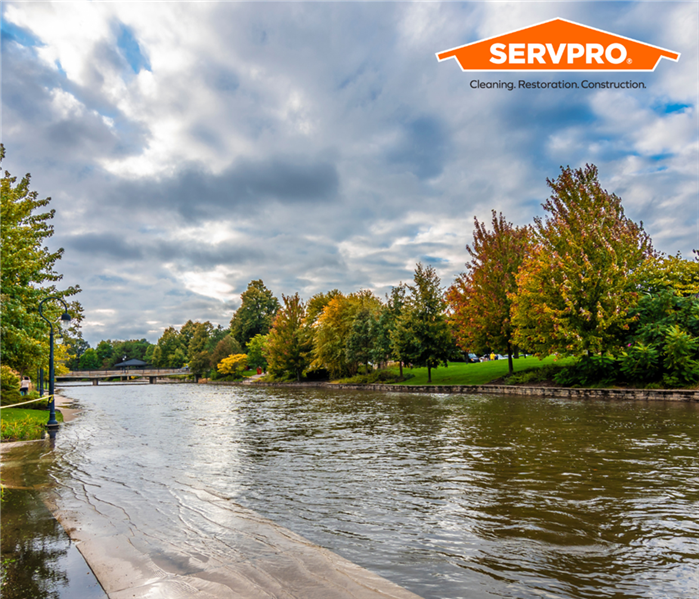 SERVPRO of Indianapolis West is always here to help. Call our office 24/7 at 317-243-3149
SERVPRO of Indianapolis West is always here to help. Call our office 24/7 at 317-243-3149
Indianapolis West residents are no strangers to heavy rainstorms that can wreak havoc on older buildings. Picture an aging roof giving way under pooled water's weight, leading to leaks into your home. Imagine water seeping down from the ceiling into your bedroom.
Our flood damage remediation services in Indianapolis and its vicinity are of top-tier expertise. With well-trained SERVPRO-certified technicians and cutting-edge technology, we guarantee the finest service possible. If you require flood damage remediation, reach out to us.
How Can I Better Prepare for a Flood?
When you're anticipating a severe rainstorm, a few steps can help you brace for potential home damage:
- Keep a list of emergency contact numbers.
- Have spare water and non-perishable food on hand in case of extended power outages.
- Consider seeking assistance and being prepared for flooding risks.
Though not all rainstorms lead to severe consequences or power loss, preparedness is always wise. Having bottled water and non-perishables ready ensures you won't be caught in a rush to the store along with everyone else. SERVPRO recommends scheduling an appointment to discuss our ERP Plan. The Emergency READY Profile Plan can help prevent or mitigate damage from intruding water, fires, and even mold.
What Can SERVPRO Technicians Do Upon Arrival?
Upon reaching your residence, our highly trained technicians can immediately take action. We can initiate the process by:
- Covering roof holes with tarps to impede water intrusion.
- Employing wet/dry vacuums to extract water from walls, ceilings, and floors.
- Utilizing air blasting tubes, including injecti-dry advanced devices, to introduce dry air into hard-to-reach areas.
At SERVPRO, we're committed to minimizing excess moisture in your home and preventing mold damage. If you face a distressing flood event, grant your home the assistance it deserves!
Reach out to SERVPRO of Indianapolis West at 317-243-3149. We're here to support you!
SERVPRO -Water Damage Professionals in Indianapolis
7/28/2022 (Permalink)
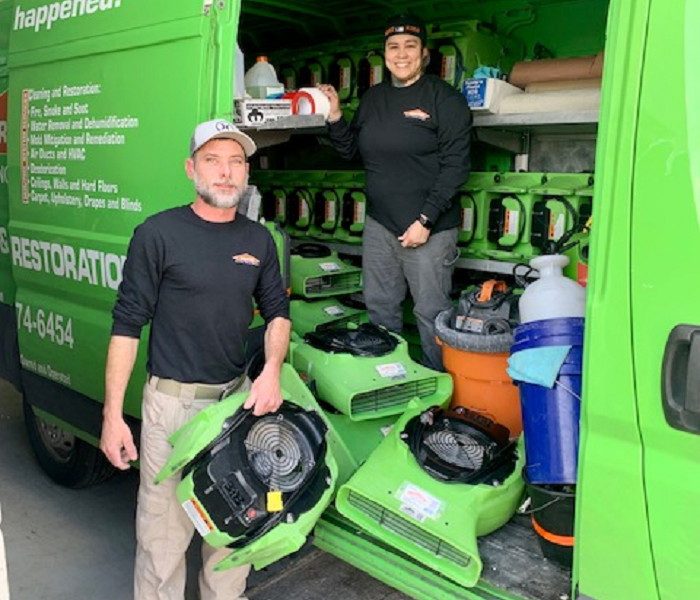 SERVPRO is always ready to help. 24/7/365
SERVPRO is always ready to help. 24/7/365
Water Damage Restoration Professionals
If you are looking for professionals with the knowledge and expertise to restore your home or business after a water damage, then call SERVPRO of Indianapolis West.
The water damage restoration professionals of SERVPRO of Indianapolis West service businesses and homes that have suffered water damage around the Indianapolis area, including Plainfield, Greenfield, Avon, Zionsville, Carmel, Fishers, and beyond.
If you've had a pipe burst, leaky roof, toilet, or tub overflowing, call SERVPRO of Indianapolis West to clean up the mess and restore your home as if nothing ever happened.
When to Call Water Damage Restoration Professionals
Water damage to an Indianapolis-area business or home can be caused in many ways. Heavy storms can reveal roof leaks and foundation cracks that let the water inside. During winter, pipes exposed to cold temperatures can freeze and burst.
Toilets, sinks, dishwashers, and clothes washers can slowly leak behind walls, under floors, and inside cabinets. Sewers can back up into basements and through the drains on lower levels of homes.
As you can see, water can get into your home and damage it in many ways. So, while one may think drinking water or rainwater isn't as damaging as sewer water or black water, that's not the case.
Will Clean Water Damage My Home?
While sewer water or blackwater, as defined, can quickly lead to mold growth in a home, clean water can also lead to dangerous mold growth. Blackwater contains lots of dirty bacteria that can quickly promote mold growth by itself.
Clean water can cause mold spores that are naturally present in the air, and dust can also lead to mold growth. The dangers in clean water leading to mold growth are that clean water can quickly go unseen in a home due to the lack of odor compared to black water.
Rainwater can leak into a home's attic, walls, or crawl spaces and linger without being spotted. This water can lead to mold spores activating and growing in these unseen areas. It's not until the mold spreads to visible parts of the home or causes a musty odor that it is finally found. Unfortunately, by that time, the damage caused by the mold can be pretty extensive.
Look for the Signs of Water Damage and Call the Experts Right Away
Whenever it rains, it's always a good idea to check around your home for any leaks. Check the external walls, ceilings, and windows. If you have a basement or crawlspace, check it for any water entering your home. Always check around sinks, tubs, showers, and washers for sitting water or even the smallest of leaks. It doesn't take much water to cause damage to a home.
The quicker you spot a leak or water in your home, the faster you can call the water damage restoration experts at SERVPRO of Indianapolis West to stop the damage and restore your home.
SERVPRO of Indianapolis West has the experience, expertise, and tools to properly and effectively remove the water and mold damage and restore your home "Like it never even happened." Call SERVPRO of Indianapolis West today at 317-243-3149.
How to prepare for a storm or flood type event close to your home.
1/28/2022 (Permalink)
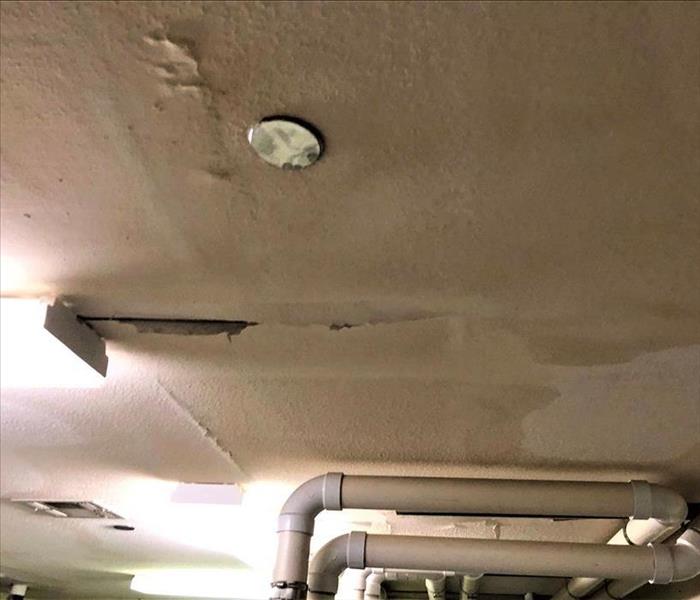 SERVPRO of Indianapolis West
SERVPRO of Indianapolis West
- Prepare a few emergency kits
- Prepare a household flood plan
- Keep a list of emergency telephone numbers
- Check your insurance policy to see if you are covered for flood damage
If flooding is predicted, make your safety a priority and if you have time try to prepare your property:
- Secure hazardous items
- Roll up rugs, move furniture, electrical items and valuables to a higher level
- Place important personal documents, valuables and vital medical supplies into a waterproof case in an accessible location
- If you are relocating, take your pets with you if it is safe to do so. If not provide adequate food and water and move them to a safer place
If rising waters threaten your home and you decide to move to a safer location, tell the police, your nearest State Emergency Service (SES) unit or your neighbors of your plans to move.
Relocating to safer ground:
- Monitor your local radio for warnings and advice
- Pack warm clothing, essential medication, valuables and personal papers in waterproof bags along with your emergency kits.
- Raise furniture, clothing and valuables onto beds, tables and into roof space place
- Empty freezers and refrigerators, leaving doors open to avoid damage or loss if they float.
- Turn off power, water and gas and take your mobile phone
- Whether you leave or stay, put sandbags in the toilet bowl and over all laundry/bathroom drain holes to prevent sewage backflow
- Lock your home and take recommended relocation routes for your area
- Do not drive into water of unknown depth and current
Too late to leave?
- Monitor your local radio for warnings
- Get to higher ground
- Switch off electricity and gas supplies to your home
- Prepare to move vehicles, outdoor equipment, garbage, chemical and poisons to higher locations
- Prepare for the wellbeing of pets
- Raise furniture above likely flood levels
- Check your emergency kits
- Do not allow children to play in or near floodwaters
- Avoid entering floodwaters,. if you must do so, wear solid shoes and check depth and current with a stick
- Stay away from drains, culverts and water over knee deep.
- Do not use gas or electrical appliances that have been in floodwater until checked for safety
- Do not eat food that has been in floodwaters
If you need help putting any of this together or still have questions about how to prepare for a storm or flood, call us at SERVPRO of Indianapolis West for additional help.
Going from Cold to Hot Temperatures
1/28/2022 (Permalink)
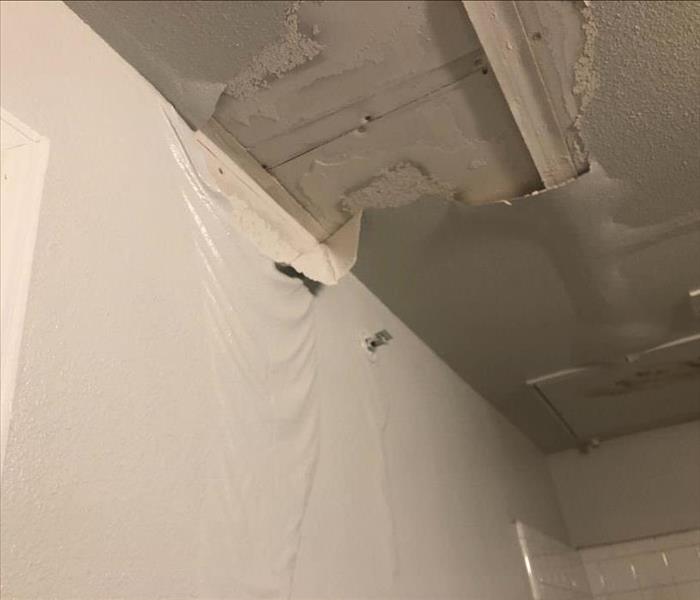 SERVPRO of Indianapolis West
SERVPRO of Indianapolis West
While it may feel like warmer temperatures relive the stress of winter issues, it isn’t necessarily the case. A spring thaw is not the time to take a step back from taking precautions needed to keep your home or business property safe.
Ice can create a lot of problems; Remember, it will be water come Spring. An abundance of ice on or around a property, with a quick increase in temperatures, can completely flood your building.
Let’s talk prep…
- Basement Preparation
The basement or lowest floor of your building will be susceptible to outside water.
- Have your foundation inspected
- Purchase an automatic sump pump
- Install flood sensors
- Elevate sensitive machinery off the floor
- Plumbing Protection
A frozen pipe can burst from a quick increase in temperatures. If the temperature change is too sudden, the pipes may not be able to withstand the contrast. Always keep the thermostat in your building set to at least 55 degrees to ensure your pipes are kept within an appropriate range.
3. Roof Inspection
Have your roof professionally inspected. Contractors can identify damage and other weak spots before additional problems are incurred. Call us if there’s any water issues detected. Our team can remediate any damage or flooding that has occurred during the winter months to limit catastrophes. A small, fixable problem can turn into a serious issue if left untreated.
4. Drainage Clearing
Outside debris, such as small twigs and leaves can clog the gutter and rainspouts needed to clear water from your property. These will need to be cleared out and checked for any blockage, as water will always find the path of least resistance.
Keep these tips in mind as warmer weather approaches. Feel free to reach out to our office at SERVPRO of Indianapolis West for additional questions and information on how to keep your property safe. Always here to help.
Types of Water Damage to Look For
1/28/2022 (Permalink)
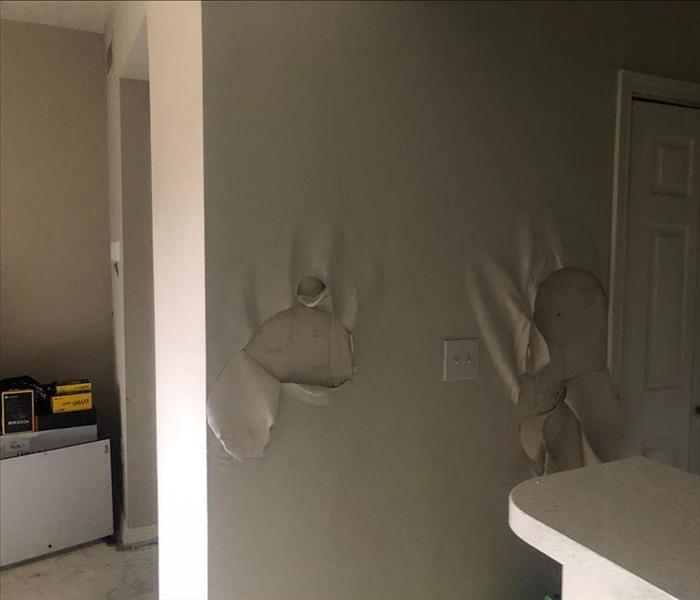 SERVPRO of Indianapolis West
SERVPRO of Indianapolis West
Knowing the difference between clean, gray, and black water can help a lot during the process and being able to understand what types of damage are covered under your insurance policy.
With any loss, there are ways to identify the level and severity of the damage that has occurred to your home.
What is Clean Water?
Clean water is water that comes from your faucet or showerhead that you can drink safely. It is also considered rainwater or snowmelt. Water damage from within your home can come from a broken water line, a busted toilet tank, a leaky washer or refrigerator, or rain or snowmelt entering your home. While clean water flooding your floors may not cause an immediate health risk, it can quickly evolve into the gray water after prolonged contact with building surfaces, material, and items. This can happen within 48 hours which is why it is important to call our team as soon as possible after a flood or water damage.
What is Gray Water?
Gray water is water that may contain chemicals or contaminants that may be harmful to your health. Gray water can come from the shower and sink drains, the washer drain, the dishwasher drain, and aquariums. Gray water can cause even more damage than clean water and can evolve into black water within 48 hours causing even further damage and health risks.
What is Black Water?
Blackwater is contaminated water from floodwaters and sewage waters. It can come from a flooded river, a backed up toilet or sewage line in your home. It can cause health effects and should be avoided.
Blackwater should be professionally removed, dried out and cleaned by professionals with the right tools and processes to ensure a thorough cleanup.
SERVPRO of Indianapolis West is always here to help. Feel free to reach out with any additional questions or concerns for future reference.
Top Reasons For Water Damage
2/18/2021 (Permalink)
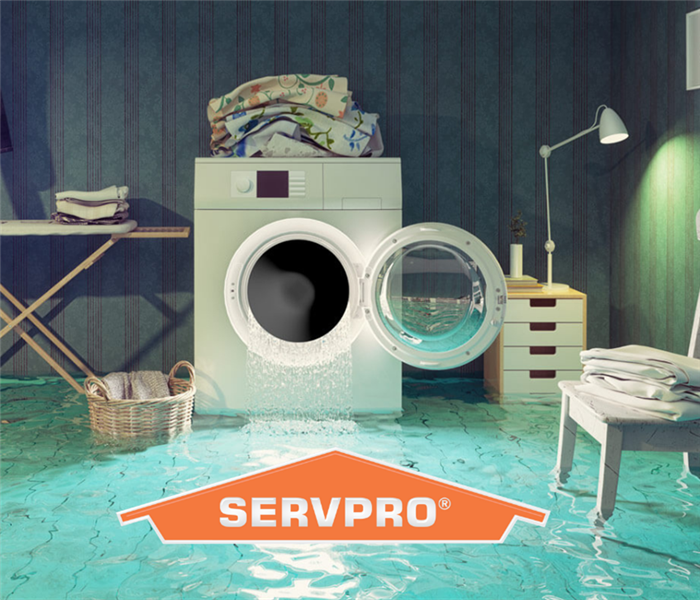 Call SERVPRO of Indianapolis West and let us make it "Like it never even happened."
Call SERVPRO of Indianapolis West and let us make it "Like it never even happened."
Water damage can happen to your Indianapolis home or business in many different ways. In this blog, we will outline some of the most common sources of water damage. It's very likely that you have had water damage at one point or another or may know someone who has.
If you think about water damaging your home, you might imagine the cause to be from a hurricane, tornado, or other natural catastrophes. The unfortunate reality is that most water damages are caused when ordinary household appliances fail. It's important to know the areas around your home that pose a threat for damage and what to do after it happens.
Washing Machines
Washing machine leaks are among the most common causes of flood damage in a home and can significantly damage the laundry room and adjacent rooms and areas. Some laundry rooms are located on the second floor of homes, and that can cause multi-level damage. Replace rubber and plastic hoses with reinforced steel braided hose. Check connections periodically to make sure they are secure and replace the hoses every five years.
Sewer and Drain Backups
Sewer water has the potential to cause health issues, not to mention the odor that accompanies it. Understandably, this can bring serious issues to the home or business owner. The water that backs up from a sewer is classified as "Blackwater." It can contain all types of harmful contaminants and can be very dangerous. For these reasons, a professional cleanup company like SERVPRO of Indianapolis West is highly recommended. Call our office, and we will respond immediately to make your home safe again.
Bathroom Leaks
Bathroom water leaks cause significant damage to a home. This is especially true if the bathroom is located upstairs. The main culprit is usually a supply line to the shower or toilet. We can't see the copper pipes that carry the water inside the walls, but we can see and inspect the toilet's supply line. It's a good idea to replace the older line with a stronger braided one. These steel braided hoses are less likely to fail and are a proactive way to lessen the chance of having a leak.
Frozen Pipes
Central Indiana is well known for having all four seasons. We have weeks in winter when temperatures drop to single digits and even in negative numbers. When outdoor temperatures drop that low homes and businesses are likely to suffer from broken pipes.
The water inside pipes can freeze when outdoor temperatures drop below freezing. As freezing water expands, it causes the pressure inside the pipes to increase, possibly leading to bursting pipes. There are a few ways to help prevent this from happening.
Insulate pipes, especially those close to outside walls, attics, and crawl spaces where the chance of freezing is greatest. Open your cabinet doors under the sinks; this allows warmer air to circulate to the pipes. Seal air leaks surrounding pipes and keep garage doors closed if there are water supply lines in the garage.
The Refrigerator
The copper pipe that brings in water to the ice maker might have a bad or loose connection, or it could be pinched. Like the other appliances in our homes, the fridge has a water supply line with continuous pressure. If that line becomes loose or broken in any way, water will spill out until the source is turned off. It's a great idea to familiarize yourself with where to shut the water off if something like this happens to you.
Sump Pump Failure
If you have a basement, you understand the importance of a sump pump. Without one, water can seep into your basement and cause lots of damage. One of the most common causes of a flooded basement is a sump pump that stopped working. This could be that the pump is old and mechanically broken, but most likely, it's due to a power supply loss. When storms roll through, we can lose power to our homes at times. That's why it's so important to have a battery backup in place in the event this happens to you.
Call The Service Professionals
If you should suffer water damage, whether from a weather-related event or a cracked pipe, overflowing bathtub, or toilet, call the water damage experts at SERVPRO of Indianapolis West 317-243-3149 for 24-hour emergency service. You can also click here to contact us online.
At SERVPRO of Indianapolis West, we have specialized equipment, professional training, and certifications that allow us to restore your home or business to its pre-water damage condition and make it "Like it never even happened."
Water Damage In Indianapolis
1/13/2021 (Permalink)
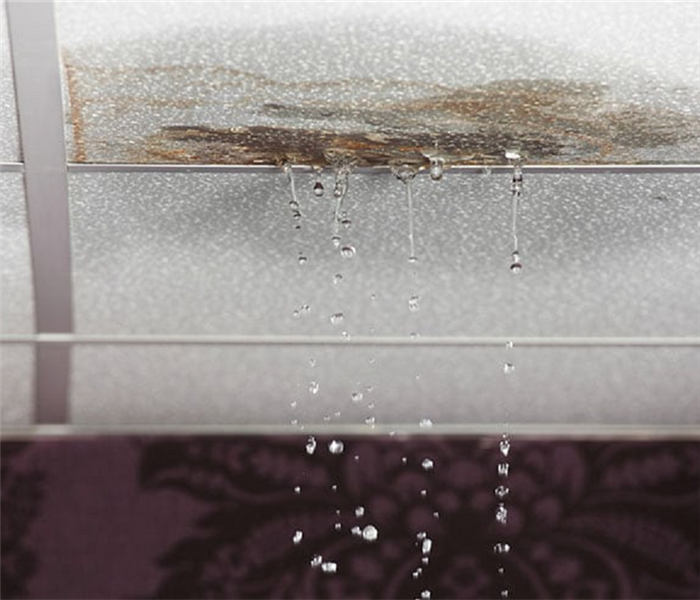 Call SERVPRO of Indianapolis West to help with your water restoration needs. 317-243-3149
Call SERVPRO of Indianapolis West to help with your water restoration needs. 317-243-3149
Do you have a small roof leak or a water spot on the floor where bathwater splashes? While those little leaks and water stains may seem inconsequential, more damage and potential health risks could be hidden underneath the surface. So what are the signs you should be looking for further water damage to your Indianapolis home?
Water Leaks
If you have a small water stain on your ceiling, you first want to determine where the water came from. If you have access above the ceiling like an attic, you can get up there and look for signs of a water leak from the roof or a leaking pipe. Even condensation from a pipe can cause water to drip and stain a ceiling over time. The source of the water leak is not always right above the water stain. Water from a leak can travel down the wood framing, across wires, along pipes and other structural pieces behind your home's ceilings and walls.
If you cannot look behind the wall or ceiling, you may want to call water damage restoration experts like us at SERVPRO Indianapolis West. We have the expertise and tools to examine the water damage's full extent and determine the best steps to repair the water damage and stop any further damage from happening.
Another sign beside a water stain of water damage is a soft spot on your home's walls, ceilings, or floors. This happens a lot around bathtubs, kitchen sinks, windows, and external walls. While there might not always be a water stain or obvious sign of a water leak, a spot where you can push in on the floor or wall, or ceiling can be a sign of water damage that is hidden below the surface. This could be an easy restoration or a potentially difficult one where there could be mold damage and extensive damage to the house's structure.
Call SERVPRO ASAP
In any case, the sooner you call us, the faster the damage can be stopped and repaired. We call this action "Mitigation," and this means to lessen the severity. When we service a home with potential water damage, we work quickly to identify the source of the water damage, the areas of the house that have been affected, then take steps to immediately stop the water leak and restore the water damaged areas and make it "Like it never even happened."
Always Here To Help
If you notice a water stain on your ceiling or a musty smell from under the wood floor, you likely have a water leak that is causing that. Our highly trained water restoration technicians are skilled at finding the source of the damage and then fully restoring your home to its preloss condition. Click here to see what out customers have to say about us. Our office is always open and always ready to respond to your call. We service all of Central Indiana, including Downtown Indianapolis, Speedway, and Clermont. 317-243-31490
Toilet Leak in your Indianapolis Home
10/26/2020 (Permalink)
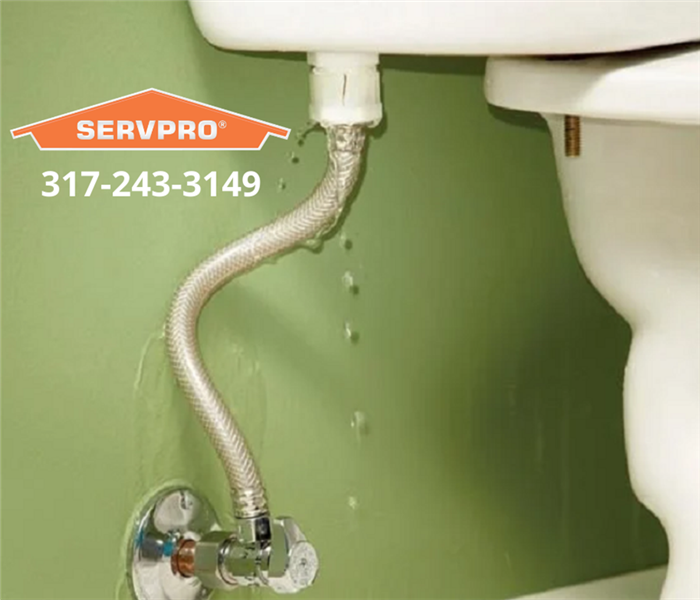 Call SERVPRO of Indianapolis West and we will make it "Like it never even happened."
Call SERVPRO of Indianapolis West and we will make it "Like it never even happened."
When a toilet in your Indianapolis home overflows, the damage can be overwhelming. There are many different ways in which a toilet can malfunction. Below, I'll cover some of the more common occurrences we see when we are called to mitigate water damages from faulty toilets.
1-Leaking supply line. This is the line that connects the plumbing coming out of the floor to the toilet tank. This line is under continuous pressure, which means that if the hose begins to leak, it will continue to spread until the water line is turned off.
2-Old worn-out mechanical parts inside the tank can cause the toilet to run continuously and even overflow onto the floor, resulting in severe water damage to the floor, walls, and everything beneath.
3-The old worn-out wax ring that is at the base of the toilet where it connects to the floor. This wax ring can deteriorate out over time, causing water to leak at the bottom of the toilet.
4-Tank-to base washer is worn-out or pinched. If the tank is not seated correctly to the base, the washer could fail. Or, if the washer has aged too much, water can leak when flowing down to the bowl.
Check Your Supply Lines
The water supply lines in a typical home or business are under and have continuous pressure, and if there's a leak or break to the supply line, water will run out until it's shut off or fixed at the main water shut-off.
It's recommended to replace the supply lines every five years. These supply lines usually are easily accessible and can be changed with pliers or an adjustable wrench. If you don't feel comfortable doing this yourself, or if you need assistance, a family member or local handyman could help you.
Time is of the Essence
When the water continues to leak, gravity will pull it down to lower levels of your home. The water can affect flooring systems, ceilings, wall cavities, and possibly insulation as it travels inside the walls. The quicker you call us, the quicker we can arrive to begin mitigation. The term "mitigate" means to lessen the severity, and that's what SERVPRO of Indianapolis West does with our fast-action response. We're highly trained to clean up and restore your Indianapolis home or business fast and efficiently.
Call The Cleanup Pros
Hopefully, you have caught the water damage early, and it can be quickly remedied. But if you do have extensive water damage, we have the expertise and training at SERVPRO of Indianapolis West to make it "Like it never even happened."
SERVPRO of Indianapolis West is here to help! Whether it's from a faulty toilet, or any other type of water damage, to fire and mold cleanup. Call us 24/7 at 317-243-3149 or click here to contact us. We are centrally located, serving all of Indianapolis and surrounding areas.
Water Damage Found After A Short Vacation
10/20/2020 (Permalink)
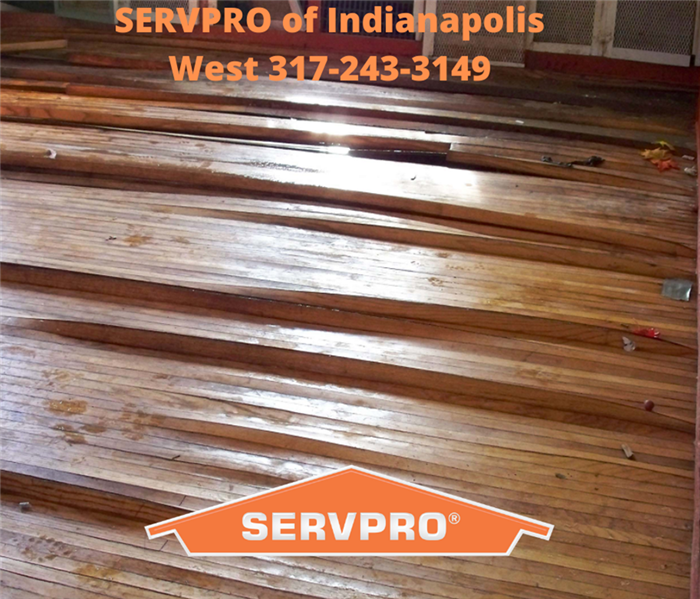 Call on us day or night, 24/7 to help with water damage like this.
Call on us day or night, 24/7 to help with water damage like this.
The Davis family came home from a short three-day getaway to find that the water heater had failed and made a massive mess in their house. They had never had something like this happen before and had no idea what to do. They found water in almost every room, soaked carpet, and the water was even under the new laminate floors.
They began using towels to soak up the water to quickly realize they were way over their heads in trouble here. Mr. Davis called his parents for advice, and his dad told him to call his insurance company. After a brief conversation with his insurance provider, Mr. Davis decided to call our office for help. His agent referred us to him, and he remembered seeing our commercials on tv.
We're Faster to Any Size Disaster
We received his call on Sunday afternoon around 1 pm, and we had a crew at their house at 3 pm that same day. We don't wait for regular business hours to work because water and fire emergencies can happen at any time. We're always open even on nights, weekends, and holidays to help our community.
The water had sat for well over two days and began to have a musty smell. We needed to remove all of the carpet and pad then removed the laminate floors in the kitchen and hallway. Once all of the wet materials were removed, we applied an antimicrobial spray to eliminate any mold or mildew growth. Finally, we installed air movers and dehumidifiers to dry the home completely.
How Long Will This Take?
It usually takes two to four days to dry a home after a water damage has occurred. We return each day to take readings of the inside air and the floors and walls to document the drying process. This ensures the structure is drying correctly and lets us know when to remove the drying equipment. In the case of Mr. and Mrs. Davis, we removed the drying equipment after just three days. We scheduled the carpet and flooring installation and did some minor repairs to the walls, and finally did some touch-up painting to complete the job.
We make it, "Like it never even happened."
The Davis's were so happy that we arrived so fast on Sunday and that by Wednesday evening, their home was completely dry and had no mold or mildew smell like it did when they come home. Along the way, we referred them to a plumber that replaced the faulty water heater for them. Mrs. Davis was so happy with us when we returned the last day to remove the equipment that she took a picture of our team and posted it on social media. Thank you for the shout out, Mrs. Davis; we really appreciate that.
A busted water heater is an every-day type of water damage that see all the time. Our office is uniquely trained and prepared to handle any size disaster. From a two-story home to a twenty-two story high rise, we can handle it all. No job is too big or too small for us here at SERVPRO of Indianapolis West.
Call The Pro's 24/7/365
SERVPRO of Indianapolis West specializes in the cleanup and restoration of Indianapolis residential and commercial property from fire, water, and storm damage. Our team of highly trained and IICRC Certified technicians are equipped with the knowledge and the equipment to handle any size disaster. As an IICRC Certified Firm, SERVPRO of Indianapolis West has been trusted by hundreds of businesses and homes throughout Indiana for cleanup and restoration of fire, water, and storm damage. Click here or call us, 317-243-3149, if your home or business should suffer from damage.
Water Damage Cleanup in Indianapolis
8/25/2020 (Permalink)
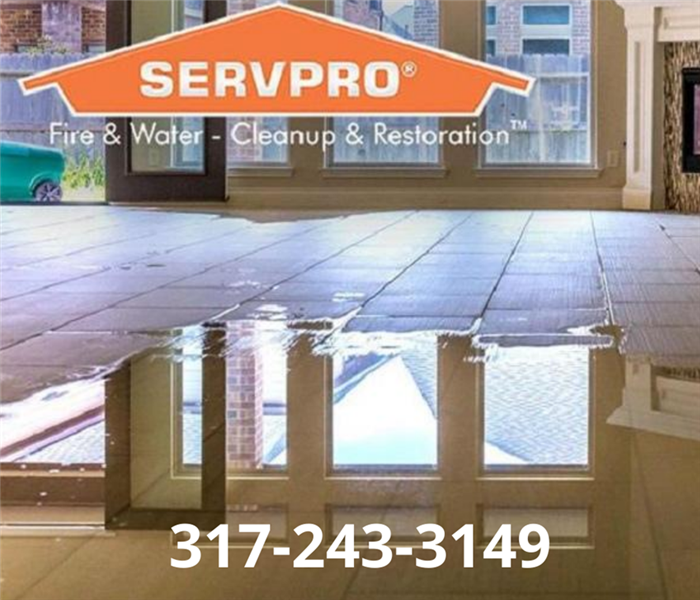 We're open 24 hours a day, 7 days a week. We'll make your water damage "Like it never even happened."
We're open 24 hours a day, 7 days a week. We'll make your water damage "Like it never even happened."
With the heavy rains and storms of summertime, we get many calls for flood damage cleanup and restoration in the Indianapolis area. While we see homes flooded from outside water, such as rivers and streams, most of the water-damaged homes we see and clean up are from water within the home. In either case, it's usually a good idea to let the professionals extract the water, clean up, and restore your flood-damaged home.
How Does the Water Get in?
There are many ways water can get into your home or business and damage it. Toilets, sinks, dishwashers, and washing machines can slowly leak behind walls, under floors, and inside cabinets. Sewers can back up into basements and through the drains on lower levels of homes. Rainwater from a massive storm can blow into cracks and crevices around your windows and doors, causing water damage that may not be discovered quickly, allowing mold to develop and cause further damage. During the winter months, pipes exposed to cold temperatures can freeze and burst.
Call us at the First Sign of Damage
A slow, subtle water leak behind a wall or under a floor can often be much worse and cause more damage than a sudden flood of water from say, an ice maker line breaking. A sudden quick surge of clean water onto the floor can quickly be removed and dried while the slower and undetectable leak may go on for days or weeks before noticed. In this case, the clean water from a slow leak then becomes unsanitary containing harmful contaminants. Sometimes these leaks are noticed by the smell of bacteria and mold growth or soft spots in the flooring.
Knowledgeable and Experienced
If your home or business does happen to suffer from water damage, you can trust the experts at SERVPRO of Indianapolis West will respond immediately to your call. We have the knowledge and experience to handle all types of water damage emergencies.
Whether from a outside flood, a backed up sewer, a roof leak, or a frozen pipe that has burst, or an overflowing bathtub or toilet, we've seen it all and can handle any size job. SERVPRO of Indianapolis West has the equipment, and the expertise to handle any size disaster, anytime, and anywhere.
Call SERVPRO to the Rescue
Call SERVPRO of Indianapolis West 317-243-3149 for 24-hour emergency service. You can also click here to contact us online. At SERVPRO of Indianapolis West, we have specialized equipment, professional training, and certifications that allow us to restore your home to its pre-water damage condition.
Whether you have a home in Speedway, live in a condo near Clermont, a home in Chapel Hill, or a place in Westwood, we are just right down the street and ready to help with any water damage emergency.
What To Do After Water Damage
8/11/2020 (Permalink)
 Be careful if you have water in your home or business. Call SERVPRO of Indianapolis West to help you.
Be careful if you have water in your home or business. Call SERVPRO of Indianapolis West to help you.
When your Indianapolis home or business has been damaged by water, we can help save cherished belongings and return your home to a safe, livable condition. Professional restoration companies like SERVPRO of Indianapolis West specialize in cleanup from water damage and have the experience and expertise to transform your home to pristine condition. SERVPRO professionals use high-tech equipment and proper cleanup procedures that provide fast and efficient results.
It is essential to hire a professional to help you dry out your home after water damage. With the right tools and pieces of equipment, we can properly and safely dry out your home or business and the contents within it. That being said, we always have customers ask what they can do to prevent further damage until we arrive with our drying equipment.
Do
-Shut off the source of the water.
-Turn off electricity
-Remove as much excess water as possible by mopping and soaking up with towels.
-Wipe excess water from wood furniture.
-Put aluminum foil in between furniture legs and carpet.
Don't
-Enter a room with standing water. There could be a risk of electrical shock. Disconnect all power first.
-Leave rugs and furniture upholstery wet against and sitting on carpets. The fabrics could bleed between each other. If you cannot move these items, we will do this for you when we arrive.
-Turn on your television or any other electronic items; they may have been damaged in the water.
-Do not use your household vacuum to try and suck up any water. They are not made for this.
We Do It The Right Way
We are water damage restoration specialist and are ready to restore your Indianapolis home or business to pre-water damage conditions. We quickly extract the water and then dry your property using state-of-the-art equipment. SERVPRO of Indianapolis West uses moisture monitoring equipment to effectively measure and document the drying process to ensure your property is dry.
Call The Service Professionals
Call SERVPRO of Indianapolis West, and our certified Water Restoration Technicians will make it "Like it never even happened." When water damage strikes, a fast response is critical. Day or night, Indianapolis residents and business owners can expect us to respond immediately to your water emergency. Call us, SERVPRO of Indianapolis West 24/7 for emergency services 317-243-3149.
Weekend Water Damage
7/24/2020 (Permalink)
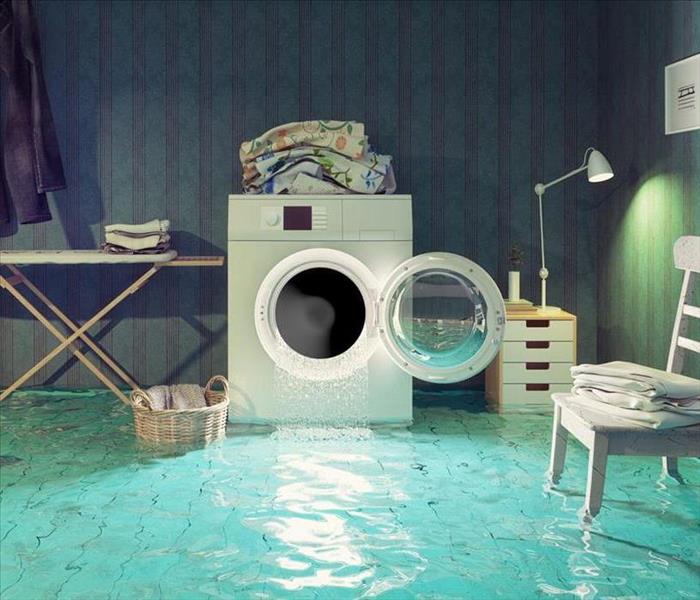 We're one call away to help save the day and make it "Like it never even happened."
We're one call away to help save the day and make it "Like it never even happened."
Waking up to water damage on a Saturday morning is never a good start to the day. Our weekends are busy with chores and getting the kids off to practice. The last thing you want to deal with is unwanted water in your home. That's where the professional at SERVPRO of Indianapolis West can help. Our water restoration crews are always available on weekends to come to save the day at your home or business.
We received a call on a Saturday morning from a homeowner in Speedway, IN, with a busted water supply line to the washing machine. Water sprayed throughout the laundry room, and the homeowner said the drywall and floors were saturated. Unfortunately, the laundry room was on the second floor of the home, and you know what that means? Yes, the water drains down and affects the ceiling and carpet below.
SERVPRO To The Rescue
It's good that the Speedway homeowner called us because this type of water damage is something we see and deal with all the time. Our crews have the experience and knowledge to immediately mitigate the problem. We have advanced and specialized equipment to detect where hidden water may be and remove it to dry your property fast and efficiently.
This particular call came in at 8:30 am Saturday morning, and by 10am, our crews were on-site to begin. Water and fire damages don't always wait for regular business hours. That's why we always have teams standing by to react to your call. We're always open for business, 24 hours a day, 7 days a week, and even on holidays. Getting the water out as fast as possible and drying your property is critical to lessen the damages and essential to a healthy home.
Check The Machine And Change The Lines
It's essential to check around your washing machine for any signs of water leakage. This homeowner's water damage was due to a busted supply line, but there are many ways a washing machine can fail and cause damage to your Indianapolis home. Check the water hookup, water drainage, and around the door for signs of water leaking.
Pressurized water supply lines are one of the leading reasons that a home may suffer a flood. Take time to inspect your washing machine supply lines. It's recommended to replace them every five years, and especially if they appear cracked or show signs of deterioration. If you have the rubber hoses, you should consider replacing those with more reliable metal braided lines. You could be saving yourself time and money, and your home from damage.
If You Need Water Removal
If you should suffer water damage from a faulty washing machine, a broken water pipe, appliance failure, or sewer backup, it's essential to quickly call us to ensure the water is removed and the home cleaned. The longer you wait and the more time passes, the more damage the water can cause, and not to mention the evil four-letter word, "mold" may begin to grow.
Whether it's in the middle of the night, on the weekend, or during the holidays, SERVPRO of Indianapolis West is always available to handle any water damage emergency. SERVPRO of Indianapolis West can help clean up the water damage and return your home back to normal. Call 317-243-3149, or click here if your Indianapolis area, Speedway, or Clermont home should suffer water damage.
Summertime Water Damage
7/15/2020 (Permalink)
 Call SERVPRO of Indianapolis West for immediate service, 24/7/365.
Call SERVPRO of Indianapolis West for immediate service, 24/7/365.
Luckily if you live on the West side of Indianapolis, you've got the top water damage restoration pros in the area at SERVPRO of Indianapolis West. Whether you have a home in Speedway, live in a condo near Clermont, a home in Chapel Hill, or a place in Westwood, we are just right down the street and ready to help with any water damage emergency.
We are available 24/7 for any size emergency. So whether it's a broken pipe at 3 in the morning on a Saturday or a flooded basement on Easter Sunday, we will be there for you. Just give us a call, and we'll be right there to help restore your home from water damage right away.
We're Experts In Water Restoration
At SERVPRO of Indianapolis West, we have the expertise and equipment to clean up and restore all types of water damage. With the frequent rains and floods in Indiana during the Summertime, water damage can occur in many different ways. At SERVPRO of Indianapolis West, we've seen it all.
With basements, we've seen water damage from sump pumps failing, sewer backups from flooding, and flooding from local streams and rivers. With the rains, homeowners also discover leaks in their roofs, which can damage ceilings, walls, and flooring. If you should suffer water damage to your Indiana home, it's reassuring to know that SERVPRO of Indianapolis West is just a call away to start the water damage cleanup and restoration.
Call The Service Professionals
Hopefully, this Summer, your Indianapolis home stays dry and undamaged from the severe storms, flooding, tornadoes, and rain. If you should suffer water damage this Summer from flooding, backups, or leaks, call the water damage cleanup experts at SERVPRO of Indianapolis West for 24-hour emergency service. At SERVPRO of Indianapolis West, we have specialized equipment, professional training, and certifications that allow us to restore your home to its pre-water damage condition. Click here, or call 317-243-3149.
Water Damage In Indianapolis
7/15/2020 (Permalink)
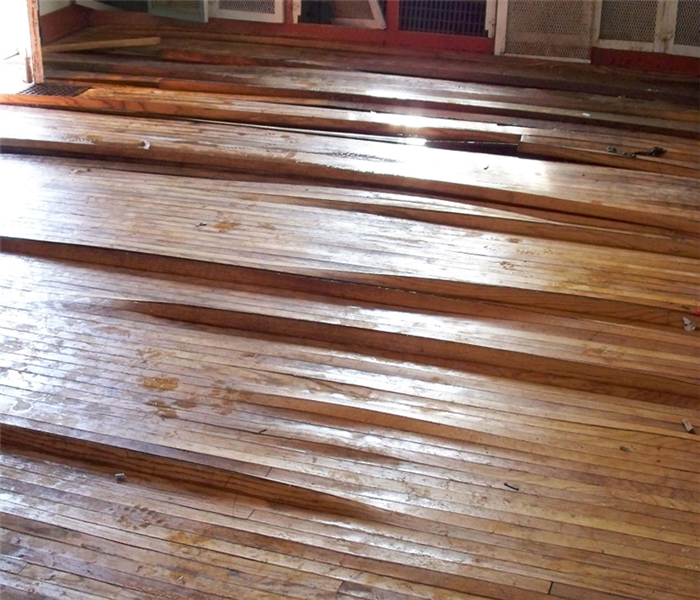 Call SERVPRO of Indianapolis West, we will make it "Like it never even happened."
Call SERVPRO of Indianapolis West, we will make it "Like it never even happened."
Indianapolis homes can suffer extensive water damage from something as simple as a broken pipe under the sink. If it happens with the homeowner present, then turning off the water under the sink and getting a mop can likely take care of it. If the same break occurs over a long weekend or while you're away, water can spill across the entire house, causing extensive damage.
Nobody plans to suddenly have 3 inches of standing water in their home. Regardless of where water damage started from a broken pipe or excessive rain, it needs to be taken care of as quickly as possible. The longer water sits, the more damage it will cause. Bacteria and mold will begin to grow, and the water soaks into materials like the walls and furniture. That is why it's imperative to call the restoration experts at SERVPRO of Indianapolis West as soon as possible.
SERVPRO Certified And Trusted
Proper cleaning and restoration of a home require a reputable, certified water remediation company that can finish the job in a fraction of the time it takes you as the homeowner to do it. Our advanced equipment helps find hidden moisture, extract the standing water quickly, and thoroughly clean and restore your home or business and belongings.
SERVPRO will arrive at your home with all the tools and equipment needed to get to work right away. We know the proper procedures for extracting water and restoring your home. We're leaders in the water damage industry, we have IICRC training and, not to mention a tremendous amount of hands-on experience.
What To Do After A Water Damage
We understand that when you call us, you may be feeling stressed, vulnerable, and confused. You need an expert to guide you through this crisis. SERVPRO of Indianapolis West has specific water damage training and experience to help you through this tough time. We specialize in water damage restoration—in fact, it's the cornerstone of our business.
Hopefully, this Summer, your Indianapolis home stays dry and undamaged from the severe storms, flooding, tornadoes, and rain. If you should suffer water damage this year from flooding, backups, or leaks, call the water damage cleanup experts at SERVPRO of Indianapolis West for 24-hour emergency service. At SERVPRO of Indianapolis West, we have specialized equipment, professional training, and certifications that allow us to restore your home to its pre-water damage condition. Click here, or call 317-243-3149
Water Damage in Your Home or Business
6/18/2020 (Permalink)
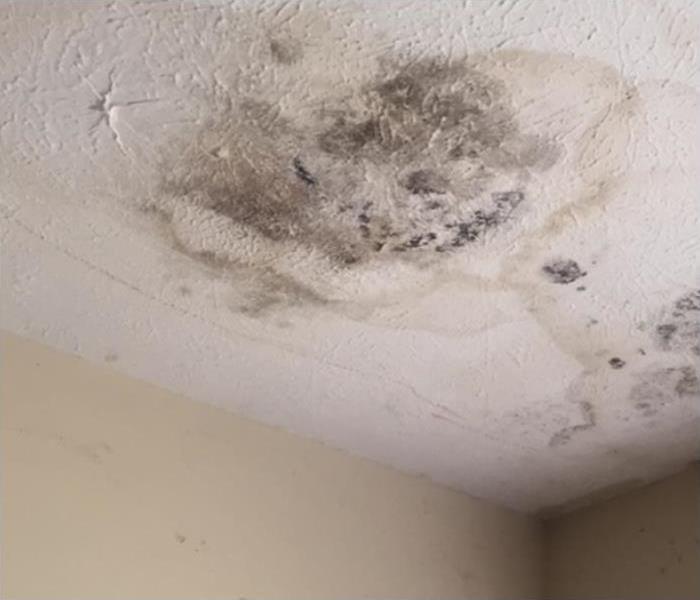 When you experience a water damage, call SERVPRO of Indianapolis West.
When you experience a water damage, call SERVPRO of Indianapolis West.
The longer you wait after having water damage, the more damage you are causing to your home or business. When you have a water leak, it's critical to shut off the water source that is causing the damage. If the water is coming from something or somewhere you are unsure of, contact a plumber in your area to stop the source of water.
Once the water is turned off, that is the source of damage; your next call should be to the service professionals at SERVPRO of Indianapolis West. Click here to contact us. We will respond to your call immediately day or night, 24/7.
It doesn't matter the size of the water damage we will be able to help get it under control. At SERVPRO of Indianapolis West, we have the capabilities and the expertise to handle large commercial losses, as well as the more common residential water damages.
Water damage can be difficult to spot, but some signs you can look for in your home and business:
- Water rings on your ceiling or walls
- Soft or sagging on your ceiling or walls
- Wet or soggy carpets
- Warping in your wood flooring
- A musty or damp smell
Signs of Water Damage on the Walls and Ceilings
A water stain or spot on your ceiling could mean you have a leak on your roof. It also could be caused by a leaky pipe or condensation dripping from a pipe above your ceiling. Roof damage can happen or be revealed as water seeps through your roof and damages your ceilings and walls.
The source of the water leak is not always right above the water stain. Water from a leak can travel down the wood framing, across wires, along pipes and other structural pieces behind your home's ceilings and walls.
Signs of Water Damage on the Floors
Wet carpet or warping floors are a sure sign of water damage. A supply line to one of the many appliances we have in our homes and businesses could be faulty. These appliance supply lines are always under pressure, so when there is a break, water will continually leak until the source is turned off.
Water seeping from a broken supply line can be substantial, causing fast and noticeable damage, while a lesser leak may take much longer to detect.
Call the Restoration Experts
If you experience water damage inside your home or business, you will want to contact SERVPRO of Indianapolis West to inspect the damage, remove the water, and remediate the damage.
From fire to flooding to water damage, storm damage and everything in between, SERVPRO of Indianapolis West at 317-243-3149, has the experience, equipment, and expertise to make it "Like it never even happened."
Does Home Insurance Cover Water Damage To Your Indiana Home?
5/15/2020 (Permalink)
When water damage happens, most people are so upset and frustrated that they don’t think about whether the water damage will be covered by their homeowner's insurance. In this blog, we will help answer the question of whether home insurance covers water damage and if it does, does it cover all water damage.
Sudden Water Damage
If you wake up the next morning after a storm rolls through Indiana and discover your basement is flooded, you will want to do two things. Call your insurance agent to start a claim and call SERVPRO of Indianapolis West to extract the water and repair the damage done.
With sudden water damage like that from a sump pump gone bad, a busted water pipe, or an overflowing toilet or tub; most homeowners insurance policies will cover the water damage. Sudden water damage is water damage that is discovered quickly rather than water damage that has been occurring over months or years.
With sudden water damage, your home insurance will most likely help cover any damage to the home structure like flooring, walls, ceilings, pipes, and more. The insurance will also most likely cover any damage to property like furniture, electronics, clothes, toys, and appliances.
With most homeowners' policies, there is a deductible that the homeowner must pay before coverage kicks in. There also may be coverage limits. That is why it’s important to call your home insurance company right away to get a claim started and to answer any questions you may have about what is covered and what is not. The professionals at SERVPRO of Indianapolis West will also be able to help with communicating with your insurance agent as they have years of experience working with pretty much every insurance company out there. We know what info they need in order to get the cleanup process started right away.
The last area that your homeowner's insurance may cover is sudden leaking from plumbing. If your toilet or tub overflows, then your insurance will most likely cover it. If a pipe bursts or comes loose and leaking water is discovered with hours and sometimes days, your insurance may cover it. If the water leak occurs and you stop the leak but don’t report the damage quickly within hours and days, you may be on the hook to cover the damage. Again, it’s a good idea to ask your insurance company about the specifics of what type of water damage they cover and how soon you should report it for them to cover it.
What Water Damage Doesn’t Your Homeowners Insurance Cover?
If a pipe has been leaking for weeks or even months causing water damage, your homeowner's insurance policy will probably not cover it. Even if the water damage isn’t visible until it seeps through a ceiling over weeks, it may not cover it. If a toilet or sink slowly leaks and rots away the floor underneath it until you notice a soft spot in the floor months later, your home insurance will most likely deny your claim. Still, you should contact your insurance agent and ask to see if they will cover the damage. Every insurance company is different and has slight tweaks to what they do and don’t cover.
If the water damage is the result of a creek or river flooding your home or basement will not be covered by a standard homeowner's insurance policy. If you live by a river or stream that is prone to flooding or you live in a floodplain, you need to purchase separate flood insurance to cover any water damage from a flood.
The other type of water damage that many don’t know that their policy won’t cover is backups from the outside sewer or storm drains. This backup usually occurs in basements and can create a really stinky mess. Ask your insurance company if your policy covers sewer backups? Some require additional coverage to cover this type of water damage.
One last thing, if your water damage is caused by an appliance that breaks like a dishwasher or clothes washer, while the water damage it caused will usually be covered, they may not cover the replacement of the broken appliance. This is because they may consider the damage to the appliance as normal wear and tear.
Call the Indianapolis Water Damage Cleanup Experts
We hope we made it a little clearer about what is covered and what is not from water damage. As we said, please contact your insurance agent to understand exactly what your homeowner's policy covers and what it does not. If you should suffer water damage, whether, from a broken pipe or flooding, we at SERVPRO of Indianapolis West can help with the cleanup and restoration. We have the tools and experience to handle any size disaster and we’re available 24/7 to answer any emergency. Give SERVPRO of Indianapolis West a call when disaster strikes your home.
Indianapolis Water Damage Repair Steps and Tips
2/19/2020 (Permalink)
 Water Damage Repair Steps and Tips
Water Damage Repair Steps and Tips
Dealing with water damage in your Indianapolis home can be quite stressful and overwhelming. Whether it’s from floodwaters or a busted pipe or leaking appliance inside the home, water can quickly soak through and damage your ceilings, walls, and floors. If it’s not caught in time, you also have to deal with potential mildew and mold growth. Just a little bit of water can result in extensive damage.
In the post below, we will go over the typical steps one would take to clean up and repair any water damage. While minor water damage may be easy to clean up for DIY homeowners, many instances of water damage in homes can be difficult to completely clean up and repair by homeowners. If not completely cleaned up, it can result in further damage to your home over time. In these instances, it’s best to call a professional water damage restoration company like SERVPRO of Indianapolis West.
1. Know the Type of Water
When dealing with water clean up, there are three types of water. The first is “clean” water which is water from faucets and water lines. This can also be water from a leaky water supply pipe. This type of water is usually easy to clean up and not harmful. If the “clean” water mixes with a dirty carpet or floor, then it is considered “gray” water. Gray water can also come from a leaking dishwasher or washing machine or an empty toilet. It’s considered gray water because it can contain cleaning chemicals, dust, dirt, food debris, and other mild contaminants. Gray water can be potentially dangerous and harmful which is why it’s important to wear protective gloves when cleaning up gray water. Gray water can also speed up mildew and mold growth due to the contaminants in the water. The last type of water is called “black” water which would be from a flood or a sewer backup. This water can be very harmful and should only be cleaned up by professionals who have the tools and protective equipment to safely remove it.
2. Assess the Severity of the Damage
The first step you want to take is to ensure the water source (if any) is turned off and the power is turned off. You can then assess the damage that the water has caused. If the water has damaged the ceilings, floors, or walls, there may be further damage behind them. If the damage is on an upper floor, you will want to look for damage in the areas below the damaged floor. Water can make its way along your home’s structure and damage ceilings and walls on floors below the main damaged floor. Without professional tools and expertise, it can be difficult to pinpoint all of the water damage, especially when it is hidden behind walls and floors.
3. Check for Mold Growth
While you may not think that “clean” water can lead to mold growth, it can along with the other water types. Mildew and mold just need moisture and a dark area to grow. If your ceilings or walls are water damaged, you will probably have to remove the damaged area in order to completely dry out the water damaged areas and to know whether there is water damage to underlying materials like wooden studs or insulation. If your carpet is water damaged, you will probably have to pull the carpet to dry it and the carpet pad underneath it. The water can also soak into the wood base floors under the carpet. If your basement was flooded, then the wet drywall may have to be removed along the entire basement before mold starts to grow. If you spot mold growth, then you will want to have it cleaned up before it spreads.
4. Remove Damaged Drywall
As mentioned in the previous tip, any wet drywall will most likely need to be removed and replaced. Removing the drywall will also let one see if there is more water damage behind the walls and ceilings. Drywall acts like a sponge and will soak up the water. Removing the damaged drywall is one of the first steps a professional will take in order to stop the water from soaking up and damaging more drywall.
5. Dry EVERYTHING Out
Once the damaged drywall and ceilings have been removed, it’s now a race against time to dry everything out. If not dried out quickly, the water damage can result in mold growth and further damage. Mold can grow under carpets, on fabrics, on wood framing, and every other porous surface if not dried up quickly. At SERVPRO of Indianapolis West, they have industrial drying fans and dehumidifiers to quickly remove all the moisture and water from the damaged areas.
6. Disinfect Damaged Surfaces
To combat any mold growth, it’s important to disinfect the damaged area with a cleaner. Many homeowners use a water and bleach solution to disinfect water damaged areas. Just be careful to not accidentally bleach your carpet or floor from the cleaner. Unlike most homeowners, water damage restoration professionals will have commercial cleaners and disinfectants that are specifically formulated to treat water damage and mold damage.
7. Replace Walls, Ceilings and Floor
Now that everything has been dried out and completely cleaned, the next step is to repair any walls, ceilings, floors, or structures that have been removed. This can be a simple job or a huge job depending on how much water damage occurred. This is also a job that is not an easy task for most homeowners and even DIYers. Replacing ceilings without the right tools can result in an afternoon of frustration. It’s usually best to leave it to the pros.
8. Paint and Seal New Surfaces
The last step to take is to paint and seal all the new surfaces. Most surfaces, like walls and ceilings, may only require a couple coats of paint. If you replace or worked around any tile, you will want to caulk and seal the edges to prevent water from seeping behind your walls and causing water damage. You’ll also want to caulk around any toilets and sinks.
Trust the Water Damage Restoration Experts at SERVPRO of Indianapolis West
If you should suffer water damage to your Indianapolis, you can trust the experts at SERVPRO of Indianapolis West to quickly clean up and repair any water and mold damage. The pros at SERVPRO of Indianapolis West have years of experience dealing with water damage to businesses and homes around the Indianapolis area. They have the tools and know-how to handle any size disaster and are ready to respond quickly day or night. If your home should suffer water damage, give SERVPRO of Indianapolis West a call.
How Some Water Damages Occur
1/14/2020 (Permalink)
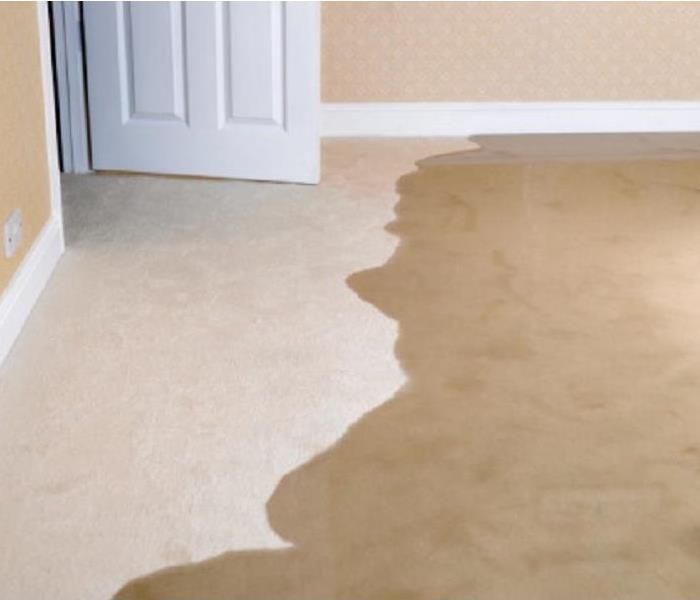 Water damages can happen many different ways. Call SERVPRO if you need help.
Water damages can happen many different ways. Call SERVPRO if you need help.
Busted Pipes
If you happen to have a water pipe burst in your home, the first thing you want to do is turn off the water to your home, or to the area where the pipe has burst. The next step is to deal with all the water and water damage.
Click here to contact us if you need assistance with water damage clean up. Even a little water can get under carpets and behind walls and lead to more problems like mold if not dealt with properly.
Leaks Around Windows and Doors
During the winter, water can seep into cracks around your windows and doors and freeze. The freezing rain can expand, causing the tiny cracks to grow to allow more water to enter into your home. Check around the outside and inside of all your windows and doors. Look for cracked or missing caulking. If you find any cracks where water could enter your home, be sure to caulk or seal the holes.
Washing Machines and Dishwashers
The washing machine is no exception to leaking, with its water intake and water drainage. Water can also leak out around the door of the washing machine from old or damaged seals. Just like your dishwasher, it's essential to regularly check around your washing machine for any signs of water leakage. Check the water hookup, water drainage, and around the door for signs of water.
Toilets
Backed up and overflowing toilets account for 78% of all water damage from toilets. Toilets failing are the second leading cause of water damage to Indianapolis homes, with pipe failures being the first. Because bathrooms occupy upper floors, the damage they can cause can be quite severe due to the water running down through the levels. On average, toilet failures cause around $5,500 in damage to homes.
Water Heaters
Water heater failures tend to occur due to the water heater rusting and corroding after years of use. These failures can start as small leaks or turn quickly into extensive water damage if there is a severe failure of the water heater tank. Just like toilets, the damage from a water heater failure is dependent on which floor it is located. Water heaters located in the basement or garage result in less damage than one that is located on the first or upper floors and fails.
We're Ready When You Need Us
SERVPRO of Indianapolis West is always ready to respond when you call us. Whether it's a water loss emergency late at night, or fire and your home or business needs secured, we're just a phone call away from being there for you. Our crews are always on standby and ready to respond. Our office always has a live person to answer your call and help with your questions.
Sometimes service isn't needed immediately and can be scheduled appropriately, most often though, the faster we're notified, the quicker we can arrive and lessen the damages with our priority response. Call SERVPRO of Indianapolis West day or night 24/7 for emergency service. 317-243-3149
Water Damage on Ceiling and Walls - Is it Old or New?
10/28/2019 (Permalink)
 Water Damage on Ceiling and Walls - Is it Old or New?
Water Damage on Ceiling and Walls - Is it Old or New?
Have you found a water spot on your wall or ceiling? Water spots on ceilings and walls are usually caused by a leaky pipe or condensation. They can also be caused by a leaky roof or leaks around a window or door. If you find a water spot on your ceiling or wall, there is a good chance that the water damage has been occurring for some time as it takes time for the water to permeate through the drywall of the ceiling or wall. But how bad is the water damage and how long has it been happening? In this blog, we will go over how to evaluate a water spot and determine how old it is and how much water damage may have happened already.
How Old Is the House?
A water spot on the ceiling or wall may be an old water spot that hasn’t seen any recent water damage in a while. This can be the result of an old roof being repaired many years ago or a bathroom renovation where an old leak was repaired. Even if the water spot is old, there can still be water damage that you will want to have checked out by a professional. Behind that old water spot could be damage to the structure or mold growth.
Touch the Water Spot
One easy way to determine if a water spot is new or old is to touch it. If the water spot is wet and the drywall is still solid, then the water spot is most likely new. If the water spot is wet and the drywall is soggy, then the water damage has been most likely occurring for some time. If the water spot is dry and the drywall is soft and crumbly, then the water damage is probably no longer occurring but the damage could still be quite extensive. If the water spot is dry and the drywall is still solid, then the water damage is probably no longer occurring and the damage may not be so extensive. Of course, there really is no telling how much water damage has occurred until you remove the water damaged drywall and examine the structure and insulation behind it.
Examine the Color of the Water Spot
A new water spot will be a solid color. The color can be light or dark, as long as it is one solid color. An older water spot will have rings of different colors around the water spot. It is kind of like a tree trunk - the more rings, the older the tree or water spot. The rings happen as a result of the water spot getting wet, drying out, getting wet again, drying out again, and repeating these steps over and over.
Examine the Building Materials
Even a small water spot can be hiding extensive water damage due to the ceiling’s materials and paint. Thick paint can hide or prevent water from seeping through and causing a water spot. Also, ceiling tiles can keep the water from seeping through the ceiling. Sometimes in these cases, the water can seep to other areas like ceiling joists, corners of ceilings, and/or walls. If the area above the water spot has insulation, the water could have been absorbed by the insulation. Depending on the materials, the water damage could have been occurring for a long time and is just becoming visible due to materials holding the water back.
Check for Mold
Check the water spot and the surrounding area for any signs of mold. It only takes a couple of days for mold spores to take hold and grow in a moist area. If there is mold growth around the water spot, then there is a chance that the mold growth is also happening behind the water spot. Unlike water damage which can take time to cause extensive damage, mold growth can quickly spread and cause extensive damage to a home in no time. Mold can spread quickly from the drywall to the insulation to the structure. If you spot mold, you will definitely want to act fast and have a professional mold remediation company analyze the damage and start the remediation process before it spreads further.
How Bad is the Water Damage from the Water Spot? Call SERVPRO of Indianapolis West to Find Out!
If you find a water spot on your ceiling or wall, it’s important to have a water damage professional examine it and determine if there is more damage behind the water spot. Even if the water spot is old, it’s still important to remove the damage and examine the area behind it as there could be structural damage or mold growth. Call the water damage and mold remediation pros of SERVPRO of Indianapolis West to examine and restore any water damage or mold growth that may have occurred. They have the knowledge, expertise, tools, and equipment to handle all types and sizes of damage. They’re available 24/7, so don’t hesitate to call them the next time disaster strikes your home or business.
Common Causes For Water Damage
10/23/2019 (Permalink)
 Changing out an old water supply line could save your home from water damage.
Changing out an old water supply line could save your home from water damage.
Pressurized water supply lines are one of the leading reasons that a home may suffer a flood. Take time to inspect your supply lines and replace them if they appear cracked or show signs of deterioration. You could be saving yourself time and money, and your home from damage.
You can help prevent a flooding disaster by checking these key areas: refrigerator lines, washing machine hoses, and toilet water supply lines. These supply lines usually are easily accessible and can be changed with pliers or an adjustable wrench. If you don't feel comfortable doing this yourself, or if you need assistance, a family member or local handyman could help you.
Let's focus on the toilet in your bathroom as a potential cause for water damage. Here are some of the most common reasons you may experience loss from a faulty toilet:
1-Leaking supply line is the line that connects the plumbing coming out of the floor to the toilet tank. This line is under continuous pressure, which means that if the hose begins to leak, it will continue to leak until the water line is turned off.
2-Old worn-out mechanical parts inside the tank can cause the toilet to run continuously and even overflow onto the floor, resulting in severe water damage to the floor, walls, and everything beneath.
3-The old worn-out wax ring that is at the base of the toilet where it connects to the floor. This wax ring can deteriorate out over time, causing water to leak at the base of the toilet.
4-Tank-to base washer is worn-out or pinched. If the tank is not seated correctly to the base, the washer could fail. Or, if the washer has aged too much, water can leak when flowing down to the bowl.
The water supply lines in a typical home or business are under and have continuous pressure, and if there's a leak or break, water will run out until it's shut off or fixed at the main water shut-off. Leaks inside walls are notorious for causing a lot of damage. These leaks are often unseen, slow, and gradual, so damage builds up and compounds itself over a period of time. To no fault of their own, home-owners don't see the problem until it's too late, and much damage has occurred.
We are water damage restoration specialist and are ready to restore your Indianapolis home or business to pre-water damage conditions. We quickly extract the water and then dry your property using state-of-the-art equipment. SERVPRO of Indianapolis West uses moisture monitoring equipment to effectively measure and document the drying process to ensure your property is dry.
Call us 24/7 for emergency water extraction and dry out your property and make it "Like it never even happened."
Crawl Space Water Damage - The Hidden Danger to Your Home
8/26/2019 (Permalink)
 Crawl Space Water Damage - The Hidden Danger to Your Home
Crawl Space Water Damage - The Hidden Danger to Your Home
There could be a lingering danger hiding out in your crawl space. This danger could already be destroying your home and you may not even know it. The danger is water damage in your crawl space. There are many sources where the water may come from and there are many ways it can wreak havoc and damage your home. In this blog, we will explore the many sources of water getting into your crawl space, what damage it can cause, and how you can reduce the possible damage.
What Causes Water Damage in a Crawl Space
If water pools up around your foundation during rain storms, the water can saturate the ground and seep under your house and into the crawl space. You want the ground around your home to slope away from the home so water will flow away from the foundation.
- Flooding from Nearby Stream or River
If you live near a river or stream that floods often, the rising water may not get into your home but it can get under your home and into your crawl space.
Usually, in crawl spaces, you will have lots of drain lines coming from your sinks, toilets, showers, washing machines, dishwashers, and tubs. Any of these drain lines can easily leak water into your crawl space.
If you live in a low lying area, you may not be that far from the groundwater table. The groundwater table or water table is the surface underground that is permanently saturated with water. In low lying areas with high water tables, your yard and your crawl space may be constantly moist and soft.
The water damage may not always be apparent when looking under your crawl space. In some instances, you may not find water but you’ll find humidity. The humidity, just like water, can lead to damage to your home under your crawl space.
Just as we explained that there are lots of drain lines that could be running under your crawl space, there could also be lots of water lines. These water lines could be running to all the same places that have a drain line. Water lines can develop small leaks that you may not discover until you inspect your crawl space. Water lines can also freeze and burst if your crawl space gets too cold in the winter.
- Gutter & Downspout Issues
The last source of water damage to your crawl space can come from a malfunctioning gutter and/or downspout. Your gutters and downspout are there to direct rainwater away from your house and it’s foundation during a rainstorm. If the gutter or downspout is damaged, it could allow water to pool up and saturate the soil around your foundation and flow into your crawl space.
What Damage Can Water Cause In Your Crawl Space?
Water and humidity in your crawl space can cause lots of damage to your entire home. Water can soak structural beams and framing of your home leading to rot and potential collapse of flooring and walls. The water can cause the humidity to rise leading to mold growth on the wood framing and subfloor. If you have HVAC ducts in your crawl space, the mold can make its way into the ductwork and spread throughout your home. If a sewer drain is leaking, the wastewater can not only cause mold to grow throughout the crawl space but also lead to awful odors emanating from the crawl space and carried by the HVAC ducts. It doesn’t take a pool of water in your crawl space for mold to start growing either. Moisture in the air and the darkness of your crawlspace are the perfect recipe for mold growth.
How to Reduce Possible Water Damage and Mold from Occurring in Your Crawl Space
While not every cause of water damage can be prevented, like a flood from a nearby stream, a lot of the causes can be. The first step to reducing any potential damage is to regularly check your crawl space for signs of water and moisture. It’s a good idea to check your crawl space at least every three months throughout the year. You want to look for any signs of pooling water, odors, mold growth, and high humidity. If you spot a leak or pooling water, you will want to find the source and fix the issue.
If you notice water pooling around the perimeter of your home, you will want to make sure that your gutters are not clogged and that your downspouts are directing water away from your home. You also want to check that the ground is sloping away from your home to reduce the pooling of water.
You also want to check the vents around your crawl space to make sure that they are not clogged or closed. The vents allow air to circulate in your crawl space to reduce moisture build-up. Ultimately, you may need to invest in a vapor barrier for your crawl space. This prevents water from seeping up into your crawl space from the ground.
If Your Crawl Space Shows Water or Mold Damage, Call the Pros
If you should find water damage or mold growth in your crawl space, call the damage restoration professionals at SERVPRO of Indianapolis West. They have the knowledge, expertise, tools, and equipment to handle water and mold damage. They will be able to quickly clean up, dry up, and get your crawl space and home back to normal. They’re available 24/7, so don’t hesitate to call them the next time disaster strikes your home or business.
Places Water Damage May Be Hiding In Your Indianapolis Home
8/13/2019 (Permalink)
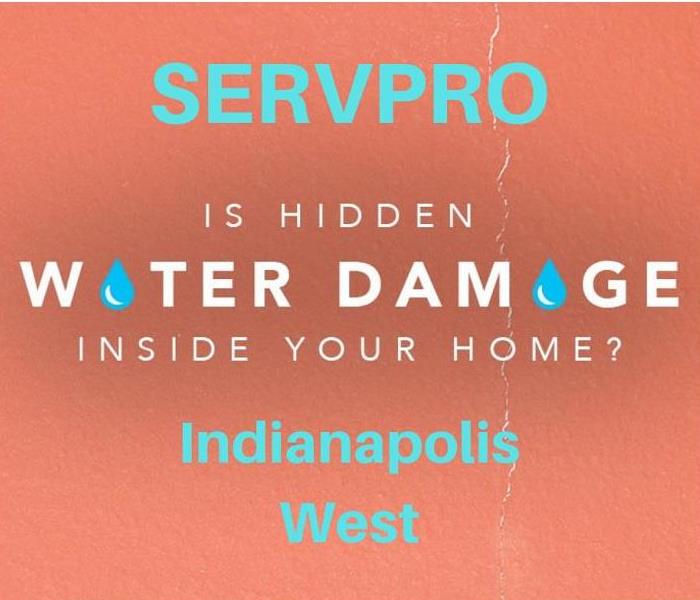 It's the water you don't see that can cause the most damage.
It's the water you don't see that can cause the most damage.
Water can be hiding around your house, and you not even know it. Heavy wind-driven rain from a storm, or even just the normal day-to-day activities can lead to water damages. Building materials and water don't mix. Insulation, wood studs, plywood sheathing, and subflooring can all degrade, rot, or develop mold when they're repeatedly saturated with water.
Making the situation even worse, this water damage is often hidden from sight, tucked away between walls or under floors. As a result, significant structural damage can occur before it's discovered. Here are some places around the house that are particularly vulnerable to getting wet, and staying wet.
Behind The Drywall After Flooding
Any time flood waters rise above floor level, whether it's from high rains or a burst water supply pipe, all drywall along the lower portion of the wall must be inspected and likely replaced. Even if the water subsides quickly and the wall looks fine, mold can be quickly develop behind the wall. Keep in mind that the electrical wiring may also have been damaged.
Under The Sink
A slow drip from a water line or the drain line beneath a kitchen or bathroom sink will often go unnoticed until a musty smell alerts you that something's not right. Because the area under a sink is dark, it's a prime place for mold to develop when moisture is present. It's a good idea to check regularly under sinks with a flashlight to ensure that a slow drip isn't causing any moisture problems.
Beneath The Dishwasher
Dishwashers are sealed to keep the water inside the tub, but leaks can develop in the joints of the water supply line that runs to the dishwasher or in the drain line beneath. Because you can't see under the dishwasher, over time a slow leak can do severe damage to the subfloor. The damage may not be discovered until you remove the dishwasher to replace it with a new one and realize, to your annoyance, that you'll have to replace a section of the floor as well.
Inside Walls Beneath The Windows
Windows are a prime spot for water leaks. Rain can seep in between the window sash and the jamb and trickle down to the framing studs in the wall without your ever knowing it's happening. Over time, repeated leaks can rot wall studs and other wood framing members, which can lead to expensive repairs.
Under The Siding
Common locations for water leaks in siding are at the corners of the house, anywhere two siding panels meet, and around the windows where the siding meets the trim. Unsealed gaps in these spots allow water to trickle beneath the siding and eventually rot the plywood sheathing that lies beneath. The damage may remain hidden until the siding is replaced.
Exterior Door Threshold
The wood beneath the metal threshold of an exterior door is subject to saturation every time it rains. While treated wood is commonly for this application, even treated wood will eventually swell and become spongy when continually exposed to moisture. Damage may not be noticed until the metal threshold starts to work loose when the wood beneath has begun to rot and can no longer support it.
Exterior Windowsills
This is a common spot for water damage in older homes with windows that have been painted numerous times over the years. Just a tiny trickle of water through cracks in the paint can slowly rot away the wood without your noticing. To check for problems, take a screwdriver and press firmly along a sill. If there's hidden damage, the screwdriver tip will sink into the soft, damaged wood.
Next To The Tub Or Shower
Wherever water lines run within walls, there's a chance for leaks to develop. While modern plumbing techniques have reduced the risk, plumbing connections (where pipes attach to other pipes) still have the potential to spring a leak. You won't have a clue that this is happening unless water begins to pool beside a fixture or the floor near it becomes spongy because the subfloor is rotting.
Under A Wobbly Toilet
To help seal the connection, a wax ring fits between the base of a toilet and the toilet flange that connects to the drainpipe beneath. The wax is soft and pliable, which makes it well suited for this job, but also means that it can leak over time. If there's a problem with the wax ring, you may notice a little bit of water around the base of the toilet, but it's more likely that you won't see any water at all—although it will be soaking into the subfloor all the same. In fact, the first indication that you have a problem may be a toilet that starts to wobble because the floor supporting it is rotting away.
Behind A Shower Surround
Unless your bathtub is a single, molded unit, there a good chance the caulk between the tub and the surround will one day fail, allowing water to leak in and damage the wood studs and framing materials. Keep an eye on the condition of the caulk, and if it's starting to discolor or pull away, remove it and replace it with fresh new caulk.
Around A Chimney
Roof penetrations, such as for chimneys, vents, and exhaust fans, extend through the shingles and roof deck. If they aren't properly sealed, water can seep in and damage the roof deck without anyone noticing. Having the roof professionally inspected annually will help pinpoint problems around penetrations so they can be repaired before you're on the hook for a complete roof replacement.
Inside An HVAC Unit
The indoor part of an HVAC unit features a shallow pan that collects condensed water that forms on its evaporator coils when the air conditioning is running. From there, the water is directed to a floor drain via a small line. If this line becomes clogged—unfortunately, not a rare occurrence—the water accumulates in the drip pan or even overflows, creating the perfect environment for mold to develop inside the HVAC unit.
Behind An Exterior Faucet
Exterior faucets are hot spots for hidden leaks because the faucet connects to a water pipe just beneath the siding—a place where it's difficult to make a secure connection. If a leak develops here, the water often runs down the inside of the wall, where it can do major damage to sheathing and framing members before it's discovered.
Behind The Washing Machine
The hot and cold water hoses from the machine attached to valves already installed in the wall. These couplings are similar to those on garden hoses, and if they're not attached snugly, or if the rubber washer in a coupling fails, they're prone to leaking. Once the washing machine is in place, the valves are typically hidden behind the machine, and a slow leak can saturate the drywall unnoticed, destroying it and allowing mold to develop.
Below A Window Air Conditioner
Air conditioners remove moisture from the air as they cool it. The moisture, or condensation, is then directed through a tube to the outside of the house. As a window air conditioner ages, the tube can become clogged, or come loose entirely, causing the condensation to spill out of the unit and drain into the wall space below, rotting wood studs and sheathing without anyone knowing what's going on.
First Sign of Fire or Water Damage, Call the Restoration Experts
7/28/2019 (Permalink)
 First Sign of Fire or Water Damage, Call the Restoration Experts
First Sign of Fire or Water Damage, Call the Restoration Experts
At the first sign of water and fire damage to your home or business, call the restoration experts of SERVPRO of Indianapolis West. We're locally owned and operated, and take great pride in working in the Indianapolis area. Our crews are always ready and prepared to take action immediately when you call for emergency services.
We Work When Disasters Happen
Water and Fire damage doesn't always happen during regular business hours; they often occur at night or on weekends. We have crews on-call ready to go at any given time. One call to our office phone number (317-243-3149) gets the restoration process started. We're open for emergency service every day, even holidays. We'll dispatch restoration technicians to you immediately because we know every minute counts when it's your home or business that is affected.
No Time To Waste
The water removal and water cleanup process starts immediately when we arrive at your home or business. We use powerful vacuums and pumps to extract standing water. Water spreads quickly throughout your property and is absorbed into floors, walls, and furniture. It's critically important to remove water from all surfaces as quickly as possible to begin the mitigation process.
The term "mitigate" means to lessen the severity, and that's what SERVPRO of Indianapolis does with our fast-action response. Once the initial mitigation services are complete, we then strategically set drying equipment to provide the best possible dry out for the structure. The drying process can be quick or may take a few days to complete.
How Do I Know My House Is Dry?
Our experience and scientific approach to water restoration gives us an advantage when drying your home or business. We use specialized equipment and advanced technology to ensure your property is completely dry. SERVPRO Technicians return each day to follow up and conduct moisture readings of the drying process. We collect individual room measurements like relative humidity and temperature. This information helps us to determine the optimal number of dehumidifiers and air movers to complete the drying process.
These moisture readings taken with our equipment are then compared to the initial readings from the water loss. We're looking to see the moisture levels fall each day as the room is going through its drying process. We electronically document this process into our computer system; this process of documentation helps validates that your home or business has been dried thoroughly and adequately.
No Job Is Too Big
We're routinely called to homes and businesses all across Central Indiana to clean up after a flood has happened. With our office strategically located on the west side of Indianapolis, minutes from I70 and interstate 465, we can be anywhere in or around the city within minutes. Fast action is critical after water and fire damage to help save property and protect your precious heirlooms. We feel like we've seen just about everything and can handle any fire and water restoration job that comes our way. From a broken ice maker line in the kitchen to a high-rise apartment building with water on every level, SERVPRO of Indianapolis is your only clear choice for restoration services.
Immediate Response 24/7
Call SERVPRO of Indianapolis West and our certified Water Restoration Technicians will make it "Like it never even happened." When water damage strikes, a fast response is critical. Day or night, Indianapolis residents and business owners can expect us to respond immediately to your water emergency. Call us, SERVPRO of Indianapolis West 24/7 for emergency services 317-243-3149.
How to Get Rid of Carpet Odor from Water Damage?
7/21/2019 (Permalink)
 How to Get Rid of Carpet Odor from Water Damage?
How to Get Rid of Carpet Odor from Water Damage?
Step inside most homes, and you will find carpeted floors. Sometimes there will be carpets only in the bedrooms, and sometimes you'll find carpets in main living spaces including basements. And in some homes, you'll actually find carpets in bathrooms. The last isn't recommended as it can quickly lead to the problems we will discuss in this blog - carpet odors.
Just a little bit of water can turn your once pristine, somewhat odor-less carpets into a musty smell reminiscent of a laundry basket full of sweaty clothes or a high school locker room. Below we will go over what causes the odor and how to get rid of it.
It Doesn't Take a Flood for Carpet Odor to Happen
If you've ever experienced water damage, you know how important it is to contact water damage restoration professionals, like SERVPRO of Indianapolis West, immediately. With their expertise and equipment, they can quickly get rid of the water, remove moisture from the air, and start drying any carpets that may have gotten soaked. After 24-48 hours, the water damage can become worse as mold begins to grow and destroy the drywall, carpets, framing, furniture, clothes, and much more. This type of mold damage is the worst-case scenario and usually results in the carpeting needing to be replaced.
In the scenarios where your carpeting has a musty type of odor, there may be a chance of getting rid of the smell and saving your carpets from further damage. Unlike the scene above where the carpeting is completely flooded and soaked, in most situations with carpet odor, there isn't any visible water damage. There isn't water dripping down a wall or a wet carpet or a drip from the ceiling pooling on your carpet. Sometimes the carpet odor can be caused by someone spilling a cup of water or moisture from the basement floor underneath the rug. Even forgetting to hang up your bath mat after taking a bath can lead to a musty carpet odor from the bath mat.
My Carpet Smells, What is Causing It
If you're paying attention, you may have noticed a constant in each of the scenarios we've discussed above. The constant is water whether it's from a dripping towel, a spilled cup, or condensation dripping off a water pipe. If your carpets get wet and are not dried quickly, they can start to smell. Going back to the bathroom, think about a damp towel. If you throw the damp towel into a pile on the ground, it may become musty after a day or two. But if you hang it up to dry, then it will usually be fine the next time you use it.
The same goes for your carpet. If the water and moisture in the carpet are not able to evaporate quickly and dry out, then it can become musty and smelly. The musty smell from your carpet is a strong indicator that mold or mildew is growing within it. If it is not treated, it can lead to premature decay and deterioration of your carpet and subfloor.
How Do I Get Rid of the Odor and the Causes of It?
If you smell an odor coming from a carpet, you can take a few steps that may get rid of the odor. The first step is to absorb any excess water with a cloth or paper towel. Then open the windows or doors around the carpet to get fresh air circulating. You can then take some baking soda and apply it to the smelly area. The baking soda absorbs odors and is usually harmless to carpets. Vacuum up the baking soda after letting it sit for a day.
If the odor persists, you can try a mixture of water and vinegar to try to eliminate the odor. Start with a mixture of one part distilled white vinegar to two parts water. You don't need to saturate the smelly area; you simply need to spray a fine mist over it and let it dry. This technique also works for fabrics like sofas and drapes.
If the Odor Persists, Call the Professionals
Ultimately, the best way to get rid of carpet odors from water and mold damage is to contact the professionals at SERVPRO of Indianapolis West. They have the tools and equipment to extract the water, dehumidify the air, and remove the odors from your carpet, carpet pads, subfloors, drywall, and framing. If you've tried everything to get rid of the odors and they keep coming back or are getting worse, you can trust SERVPRO of Indianapolis West. They will not only get rid of the odor, but they'll find and address the source so that it doesn't happen again. Give them a call for all of your water, mold, and fire damage.
Who is Responsible for Water Damage in Your Condo?
7/17/2019 (Permalink)
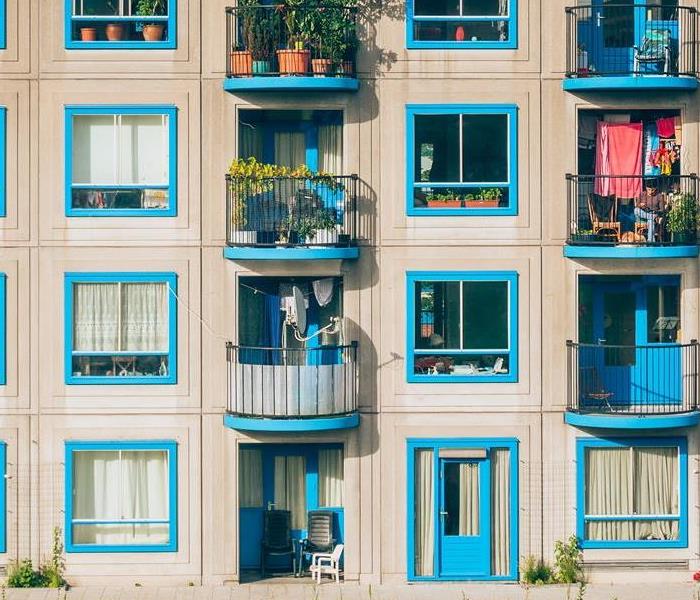 Who is Responsible for Water Damage in Your Condo?
Who is Responsible for Water Damage in Your Condo?
Let’s say you come home to your Indianapolis condo after a long at work and find that water is flowing down the stairs that go to your condo. You walk into your condo and find your carpets are soaking wet and there is water flowing down your wall. You might be wondering who is responsible for all this damage to your condo, the hallway, the stairs, and as you learn later, the water damage in the condo below yours? Well, there is no one answer. It may be you, it may be the condo owner above you, or it may be the HOA or landlord. In this blog, we will help determine who is responsible for water damage and who to call to get it all cleaned up.
Ask to See Your Condo’s Master Insurance Policy
Before any disaster happens, you will want to be familiar with your condo’s master insurance policy. This policy should be available from your condo board, condo HOA, and/or landlord. This insurance policy is what protects the areas outside of your actual residence. These could include the roof, the common hallways & stairways, and the exterior walls of the actual building. It’s important to note where your responsibility begins, and their’s ends.
With walls between residences, the actual line may be the middle of the wall. Even with exterior walls and roofs, the line between your responsibility and the condo board could be in the middle. The reason why it’s essential to know the exact area that you are responsible for is to ensure that your home insurance policy covers that exact area. Having this info is important because if your policy falls short of the area that you are responsible for - you could end up owing lots of money.
So Who is Responsible for Water Damage to Your Condo
Now that you know the areas that the condo’s master insurance policy covers and the areas that your insurance policy covers, you can then determine who is responsible. But first, you need to know where the water that is causing the damage began. If the water is coming from rain waters that are dripping through a hole in the roof, then the condo is most likely responsible. If the water is coming from a leaking pipe behind your bathroom wall, then it depends on whether the master insurance policy clearly states who is responsible for that area.
In instances, where the pipe is in the middle of a wall, and the policy divides responsibility in the middle of the wall, you may find yourself and the condo board pointing fingers at each other. This gray area is where it could become quite frustrating if you have a condo board or landlord who isn’t cooperating.
In another instance, if the water is originating from another residence, then that residence’s insurance policy is most likely responsible for all the damage that has occurred. However, your insurance company might also need to be involved and seek reimbursement from the other residence’ insurance company.
You may also find yourself using your policy to repair water damage in your apartment, while the condo HOA uses its policy to repair the leaking roof. A situation where your policy and the condo’s master insurance policy won’t cover any water damage is when it is a result of flooding. If you are in a flood-prone area, you will usually need a flood insurance policy to cover any costs that may occur as a result of a flood.
If Water Damage Occurs, Act Quickly
If your Indianapolis condo should experience water damage, it’s essential to act fast as mold can start to grow within 48 hours of the water damage. If the water originated from outside your residence, contact your condo management immediately. If the water came from another apartment, try to get in touch with them to work with their insurance company. Ultimately, you want to contact a water damage restoration company, like SERVPRO of Indianapolis West, as soon as possible and worry about the responsible insurance party later. The professionals at SERVPRO of Indianapolis West are ready to respond 24/7. They can act quickly to get the water damage cleaned up, and your condo dry before further damage has had time to occur. If there is mold damage or other damages to your condo, they have the equipment and tools to help with it all.
Small Water Leaks in Bathroom that Could Result in Lots of Damage
6/28/2019 (Permalink)
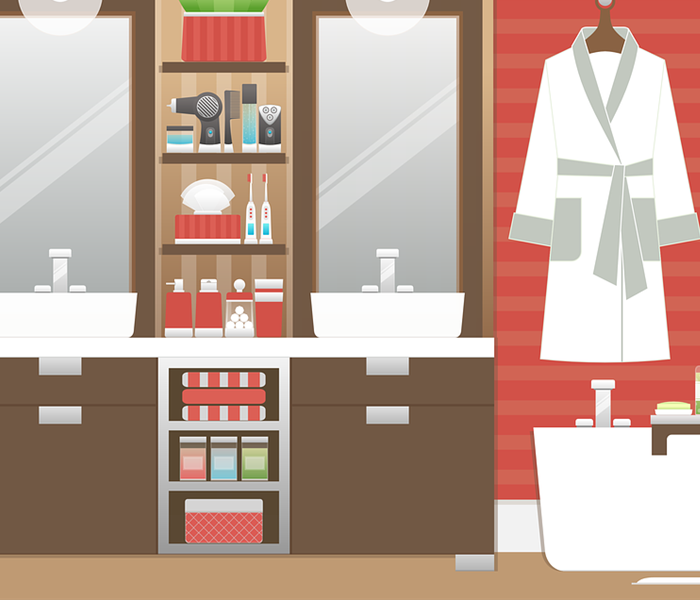 Small Water Leaks in Bathroom that Could Result in Lots of Damage
Small Water Leaks in Bathroom that Could Result in Lots of Damage
What You Don’t See Will Probably Hurt Your Home
If there is one room/s in your home that has the highest risk of causing water damage to your home, it is your bathroom/s. Even a simple half bathroom with a sink and toilet have the potential of causing water damage. Add a bathtub or shower or both to a bathroom and you have a lot of sources that could leak water resulting in extensive water damage. The worst part of water damage in your bathroom is that many times the initial water leak and the damage is hidden behind walls and under floors where the water leaks won’t be discovered until it’s much worse. While there is little you can do with hidden leaks, there are signs to look for and other areas to check for leaks that may help you uncover the hidden leaks before the water damage has escalated. Below we will cover the major culprits of water leaks in a bathroom and where and how to check for leaks.
Toilet Leaks
There are a few areas around a toilet that can leak. The water leaking can be grey water from the tank or even more harmful black water from around the toilet flange where the toilet base connects to the waste pipe. To check for leaks around the tank, take a flashlight and look for any water or condensation around the water supply connections and the flush valve. The water supply hose usually connects to the water supply valve and the tank connection. Use your hand to check for any water or moisture around these two areas. If there is leaking, you can usually stop it by tightening the connections. You may have to turn off the water supply and reseat the connections with plumbers tape if the leaking doesn’t stop.
The second source and prone to cause the most water damage is a leak around the toilet flange. The toilet flange is where the toilet base connects to the waste pipe in the floor of the bathroom. To seal the connection between the toilet flange and waste pipe, there is usually a wax ring that seals the connection. This wax ring can become damaged during the installation or break down over time allowing water to seep out after every flush. The problem with this type of leak is that you might not see it until it’s caused substantial damage due to the fact that the flange and waste pipe are hidden behind the porcelain base of the toilet. If the area between the floor and the base of the toilet is not sealed with caulk, you may notice water seeping out which is a sign that there is a leak around the flange and wax ring. If your toilet is located on an upper floor, you may find water stains on the wall and ceiling of the lower floor below the toilet. If you do find any signs of water leaks or damage, it’s important to stop using that toilet immediately and call a water damage restoration company like SERVPRO of Indianapolis West.
Leaking Sink Hoses and Pipes
Just like the toilet, water can leak from the water source and the drain. To check the water supply hoses, you will either have to look inside the cabinet below the sink or behind the pedestal, if it’s a pedestal sink. Unlike the toilet, there will usually be two water supply hoses - a hot water supply and a cold water supply. You can use your hand to feel for any water or moisture around the hose connections. You also want to check the valve for any leaks around it. If there is some water, you can use pliers to tighten the connection. You may also need to remove the hose and reseat the threads with plumbers tape to make a watertight connection.
The other area where you will typically find water leaks is around the drain pipe underneath the sink. Pipes can leak over time as a result of getting bumped or damaged. They can also start leaking as a result of a slow or clogged drain due to the fact that the water backs up inside the drain and finds the easiest way out which can be a small leak around one of the drain pipe connections. With a fast flowing open drain, you may not have known there was a loose connection because the water flowed freely down the drain. The other area where you may find a leak is between the sink drain and the drain pipe connection. These leaks can usually be fixed by clearing out the drain so water doesn’t back up and tightening the connections between the drain pipes.
Shower and Tub Leaks
WIth showers and tubs, you are dealing with a lot more water than sinks and toilets. With all that water, you’re also facing a lot more potential areas where water can leak and cause damage. We’ll start with the bath/shower faucet handles. The faucet handles usually connect to a cartridge valve that can adjust the amount of hot or cold water that flows through the tub faucet or shower head. If these cartridges aren’t tightened completely or loosen over time, they can start to leak behind the shower/tub wall. Signs that this is happening can be water stains on the drywall nearby or a shower/tub wall that feels soft or has some give to it.
The other way water can leak and cause damage behind the shower or tub wall is through cracks in the tile grout. You also want to check the caulking between the shower/tub wall and the base. Another area is water can seep around the faucet handles if they haven’t been caulked and sealed properly.
The other area where water can leak and cause a lot of hidden damage is leaks around the drain of the shower/tub. You may find water seeping out from under the edges of the tub or shower but most times, you don't know water is leaking until the floor becomes so damaged that it collapses or sinks underneath the bath/tub.
The last area to check for and one that can easily be fixed is leaking around the bottom of the shower/tub door. After taking a shower, you can quickly check to see if the water is making its way through the space between the door and base and onto the bathroom floor. If you find leaks around the base of the shower door, you can quickly caulk and seal the area. Over time, water seeping out onto the bathroom floor can cause damage to the floor and promote mold and mildew growth.
Check Your Bathrooms For Leaks and Water Damage
It’s always a good idea to check for leaks and water damage on a monthly basis especially for bathrooms that are used a lot. It doesn’t take long for a little water to cause big problems in a bathroom. If you do discover extensive water damage or mold problems, contact the water damage restoration professionals at SERVPRO of Indianapolis West. They have the equipment and expertise to handle all levels of water and mold damage to your bathroom, kitchen, laundry room, basement or any other room in your home.
5 Reasons To Call SERVPRO This Spring
3/27/2019 (Permalink)
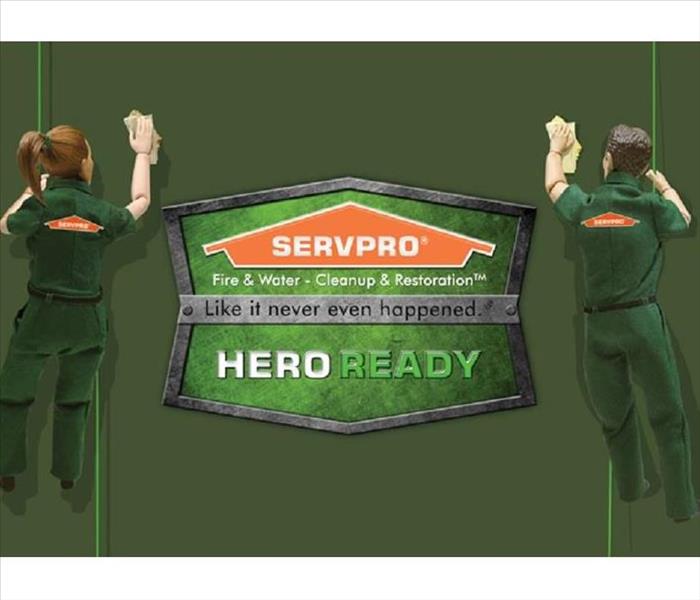 Our Hero's will make Springtime floods "Like it never even happened."
Our Hero's will make Springtime floods "Like it never even happened."
With the rainy Spring season upon us, many homes and businesses will be the unlikely victims of water damage. Some may experience flooding in low lying areas while others may experience leaky roofs or windows or flooded basements. While there are many ways for water to creep into your home, there’s one sure choice when it comes to choosing someone to remove it. With one call to SERVPRO of Indianapolis West at any time and any day, we can be at your home and business Faster To Any Size Disaster removing the water and restoring any damage that it may have caused. Why is SERVPRO of Indianapolis West the best choice in the Indianapolis area when it comes to water damage restoration? Here are the top five reasons why you should give them a call the next time you experience water damage:
#1 IICRC Certified Professionals
The IICRC is the leading, independent, non-profit, certification and standard-setting body in the cleaning, inspection, and restoration industry. When choosing water damage, mold remediation, and fire and smoke restoration company, be sure to ask if they are IICRC certified.At SERVPRO of Indianapolis West, Our Team holds IICRC certifications in water removal technician (WRT), applied structural drying (AST), mold remediation technician, and lead paint remediation. The team also participates in ongoing training at SERVPRO’s corporate training facility. #2 Ready for Any Emergency 24/7
A disaster can strike at any time and any day which is why SERVPRO of Indianapolis West is ready to answer your call 24/7. With water damage, time is of the essence, and it’s important to start the process of removing the water quickly before it can cause further damage or lead to mold growth. SERVPRO of Indianapolis West realizes that every water damage situation is an emergency which is why they are ready to help out whether it’s day or night. #3 Known and Trusted for Over 50 Years
SERVPRO has been around for over 50 years. That’s 50 years of industry experience and know-how in the fire and water cleanup and restoration industry. When you call SERVPRO of Indianapolis West, you can trust that they have the skills and the expertise to handle any emergency no matter how big or how small. There are not many fire and water restoration companies that can say they’ve been around as long. #4 Advanced Equipment
Treatments and TechniquesWith that 50 years of experience comes 50 years of learning the best techniques and the right treatments to cleaning and restoring business and homes from fire and water damage.
Along with the best treatments and techniques come some of the most advanced equipment in the industry. Trust and reliability and excellent results come from 50 years of experience dealing with every disaster imaginable. #5 Experts at More Than Just Water Damage
Many times, water damage isn’t the only thing that a homeowner or business owner is experiencing. If the water damage has been happening over some time, there could be underlying mold damage. If a home or business experience a fire, there could be water damage from the fire department and sprinkler system. If the water isn’t removed completely, there could be water damage and mold growth. Luckily, SERVPRO of Indianapolis West can handle all of those quickly and professionally. Call the Experts for Water Damage Cleanup and Restoration
If you should, unfortunately, experience water damage to your business or home, call the experts at SERVPRO of Indianapolis West. They have the expertise, the knowledge, the equipment, and the know-how to remove the water and restore your home or business. Contact SERVPRO of Indianapolis West online or call them at 317-243-3149.
Springtime Check List
3/27/2019 (Permalink)
 "An ounce of prevention is worth a pound of cure." -Benjamin Franklin
"An ounce of prevention is worth a pound of cure." -Benjamin Franklin
Springtime is upon us in Indiana. It’s time to start thinking about planting some flowers and getting your lawn mower ready to start the long mowing season. There are lots to look forward to in the Springtime, but there are also lots of things that need to be done to make sure your home is up for the season. Below we cover five things to check in your home to make sure it is free of water damage and mold damage - and ready for Springtime.
#1 Check Your HVAC System
As the warm weather approaches, you need to make sure your air conditioner is ready. The first thing to check and most likely replace is the air filter. The air filter catches allergens and reduces the buildup of dust in your home’s air ducts. It would help if you also made sure that there is no standing water or dirty air coils where mold can grow and then be pushed through the air ducts. #2 Check Around Your Windows & Doors
During the winter, water can seep into cracks around your windows and doors and freeze. The frozen water will expand causing tiny cracks to grow to allow more water to enter into your home. Check around the outside and inside of all your windows and doors. Look for cracked or missing caulking. If you find any cracks where water could enter your home, be sure to caulk or seal the holes. #3 Check Your Roof for Damage
When it’s nice out and your roof is dry, if you're comfortable climb up there and do an inspection, or call a qualified specialist to help you. Check to make sure your gutters are clear. Otherwise, water could run over the gutters and cause water to enter through your foundation and into your basement. Also, check to make sure there are no missing shingles. If you have exhaust pipes or chimneys, check around them to make sure they are sealed and there are no signs of cracking. #4 Check Attics, Basements and Crawl Spaces for Mold
As the ground thaws out from the Winter, water will find its way into your crawl spaces and basements. If you have any roof damage, it could seep into your attics. Make sure to check all these areas for any signs of water. This could be standing water or water stains. If your basement or crawl space smells musty, then you may want to get a dehumidifier to remove the excess moisture from the area before it leads to mold growth. If you do find mold growth or water that you can’t remove, then call the professionals at SERVPRO of Indianapolis West to help remediate the mold damage. #5 Check Exposed Water Pipes
If you have water pipes in your basement or crawl space that you can see, make sure to check them for any drips around the joints and connections. During the Winter, these pipes could have frozen causing the plumbing to expand and crack. Even a small drip can lead to extensive water damage and mold growth. It’s also a good idea to check any external faucets for cracks or leaks. If you find any sign of leaks, make sure to have it fixed before it leads to even worse damage. Enjoy a Stress-Free Spring
While you can’t ultimately reduce the risk of water damage to your home, you can lower the risk by following the five steps mentioned above. If you should experience water damage or find mold growth when inspecting your home, contact SERVPRO of Indianapolis West online or call them at 317-243-3149 to help clean up the damage and restore your home.
What to Do If Your Home Has Water Damage
2/25/2019 (Permalink)
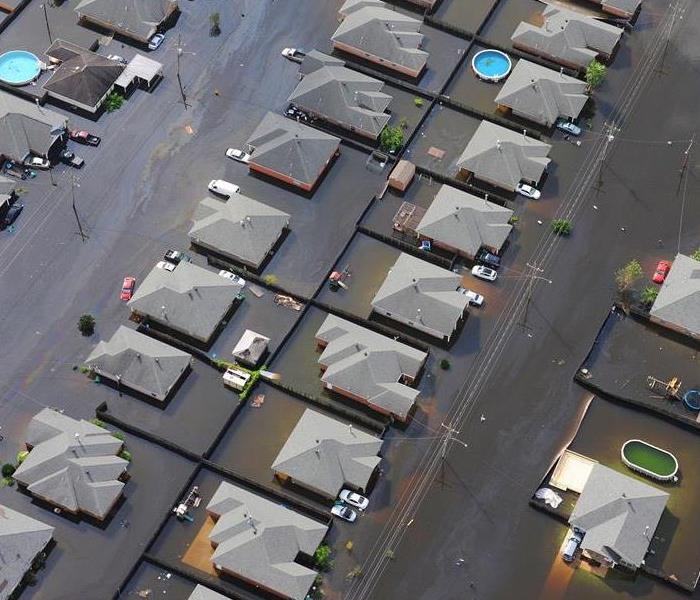 What to Do If Your Home Has Water Damage
What to Do If Your Home Has Water Damage
The first half of the year tends to be some of the wettest in Indiana. From the frozen, saturated ground of late winter to the constant rain storms of spring, dealing with the water and trying to keep it out of your house can be a constant battle. So what do you do if your home should be the unfortunate victim of water damage this time of year? Below we will go over the steps you should take to lessen the water damage and get your home restored quickly.
Shut Off the Water
If the water is coming from a broken pipe, then you will want to shut off the water immediately. If the water is flooding into your home from the outside, then there may not be much you can do.
Move Valuables to Higher Ground
If you are experiencing flooding, you will want to move any valuable furniture and household goods to a second floor or up onto a countertop or table. You especially want to move any photo albums, books, and clothes to an area that is less prone to be flooded like a second story floor.
Take Pictures of the Damage
It’s important to take pictures of the water damage before trying to clean things up or remove the water. If you have a flooded basement or flooded first floor, be sure to take pictures of all the water damage. This can be important and helpful when filing an insurance claim. If the water damage came from a burst pipe, be sure to take a picture of the pipe.
Don’t Use Electricity in Water Damaged Areas
If you should suffer extensive water damage, you may want to cut off the power to the whole house. However, if your circuit box is in an affected area, like a basement, do not touch or attempt to check the circuit box. If your circuit breaker is in a dry area, then you may want to make sure the circuits to the water damaged area have been tripped. If they haven’t, you may want to flip them off to reduce any risk of electrical shock.
Start Removing the Water
If you can get the water out of your house, start doing it as quickly as possible. While a water damage restoration company, like SERVPRO of Indianapolis West, will remove all of the water; you can reduce the severity of the damage by starting to remove the water. The longer the water sits in your home, the more time it has to damage your home. Standing water can soak further into your drywall, insulation and wood framing leading to more damage from the water which can quickly lead to mold growth and damage.
Get the Air Circulating
To help reduce the risk of mold damage, it’s important to get the air circulating. If the weather is nice, you can open your windows and doors to allow the outside air to blow through the home. You can also employ fans and blowers to get fresh air circulating around the water damage. If you are in a basement or an area that is particularly damp, you can also use dehumidifiers to draw the moisture out of the air. This can all help to reduce any further water or mold damage to your home.
Call the Water Damage Restoration Professionals
The last step is the most important step to take to get your home back to normal quickly. Don’t just trust anyone to restore your damaged home, trust the professionals at SERVPRO of Indianapolis West. They have the knowledge, expertise, and equipment to handle any size disaster. From water damage to mold damage to fire damage and more, they have the skills and expertise to clean up the mess, fix the damage, and return your home back to normal. Give them a call any time and any day for your fire, water and mold damage problems.
Tips to Prevent Winter Moisture Problems
1/22/2019 (Permalink)
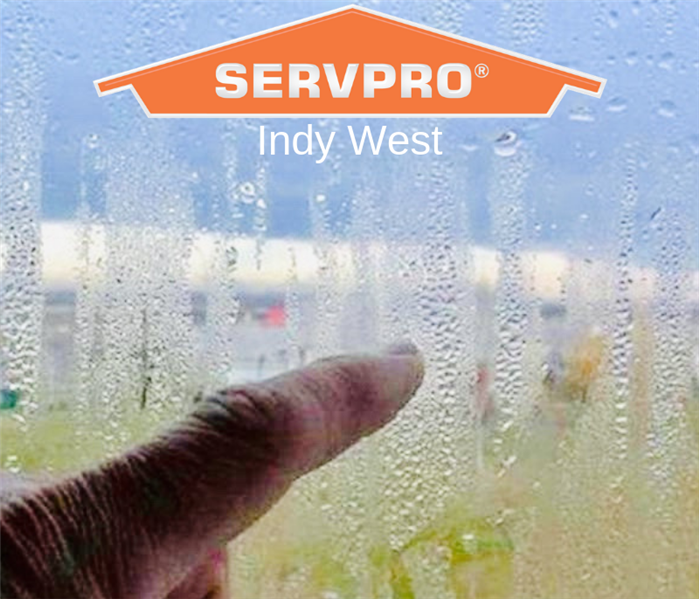 Tips to Prevent Winter Moisture Problems
Tips to Prevent Winter Moisture Problems
During the cold winter months in Indiana, we tend to keep our homes sealed up tight from the elements. As a result, Indiana homes can suffer from moisture build-up and/or dry air. Both of these symptoms can cause problems and damage to your home. In this article, we will focus on the more damaging effects of moisture in the home during the winter months. We will point out areas that are prone to moisture build up and what to do to fix these problems.
Is Your Home Too Humid?
How do you know if there is too much humidity in your home? There are signs that you can look for and smell for. The first sign of excessive moisture is condensation on the exterior doors and windows. Another sign is a musty smell in the home. Does your house smell like a musty basement or crawl space? Are your bathrooms, laundry room, or kitchen smell musty? If you smell a musty odor, there is a good chance you have an excessive moisture problem. That last sign of excessive moisture is mildew and mold growth. Common areas where you might find mildew and/or mold are around windows, in bathrooms, near water pipes, in dark areas of your home, and in your basement.
How to Reduce Moisture & Fix Problem Areas
Seal or Replace Your Windows
If you have condensation around your windows or doors, first make sure that they are closed completely. If you haven’t closed your windows fully, cold air can seep in and condense around the leak. If your windows are badly insulated or leaky, you can replace them or try taping up any drafts. On really bad windows, some people use plastic sheeting to seal the windows during the winter as a temporary fix.
Use a Dehumidifier
A dehumidifier is a popular choice for many Indiana basements. A dehumidifier will pull the excess moisture out of the air to keep mold and mildew at bay. You can also use a dehumidifier in bathrooms, laundry rooms and other areas where there is excessive moisture. You obviously want to monitor your dehumidifier and adjust it if the air gets too dry. Dry air can also cause damage to your home. The better dehumidifiers have humidistats that you can set to regulate the humidity level.
Improve Airflow
While you can’t open your windows to get fresh air in during the cold winter months, you can keep your ceiling fans on to push and pull the air through the rooms. You can also set your HVAC fan to be always on to help push the air throughout your home. Airflow can help lower the moisture in high-risk areas like basements and bathrooms by blowing the air throughout the home. You can also keep your interior doors open to allow air to move in and out. This is especially important for bathrooms. While bathroom exhaust fans can pull the moisture out of the room when taking showers and baths, leaving the door open can allow any moisture build-up to dissipate into the rest of your home.
Keep Rugs and Floors Dry
With snow and rain, water can be tracked into the home fairly easily. It’s important to make sure you keep doormats and rugs dry and clean. If they get too wet, they can cause mold and mildew to grow under them. Also, if you take off your shoes at the door, make sure you clean up any melted snow each day. It’s best to either throw any wet snow pants, jackets, glove and hats in the dryer when you or your kids come inside.
Stay Warm and Stay Dry This Winter
Moisture problems are common during the cold, wet, winter months in Indiana. By following the steps above and keeping the floors dry and clean, you can greatly reduce any risks of moisture and water damage. If you should experience water damage or mold damage to your home this winter, it’s important to act quickly to reduce further damage and call the experts at SERVPRO of Indianapolis West. They have the expertise and equipment to fix the damage and takes steps to prevent it from happening again. Give them a call any time and any day for your fire, water and mold damage problems.
Indianapolis Home Water Damage Facts & Statistics
10/25/2018 (Permalink)
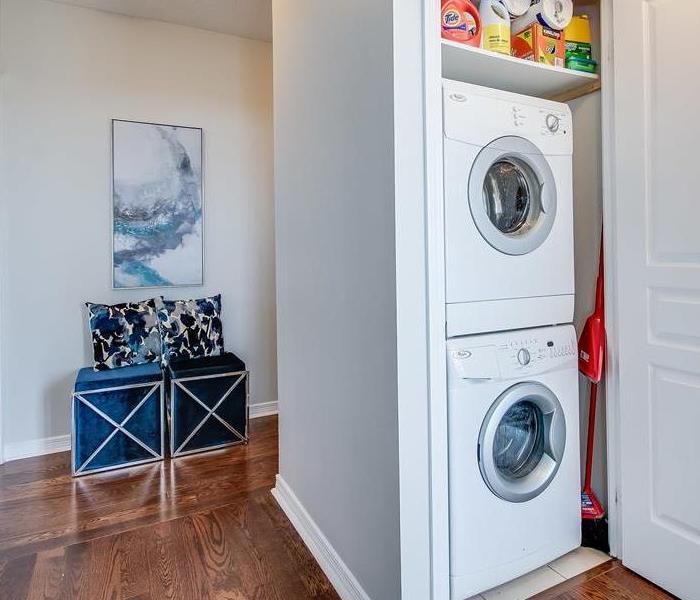 Indianapolis Home Water Damage Facts & Statistics
Indianapolis Home Water Damage Facts & Statistics
Did you know that water damage and freezing are the second most common damage to a home just behind wind and hail damage? According to the Insurance Infomation Institute, a single family home over 100 years will file 2.38 claims for wind and hail damage and 1.99 claims for water damage and freezing on average.
In this blog, we will dive through the facts and statistics on water damage to Indianapolis-area homes. While some things are unpreventable, there are some statistics that might help you prevent or reduce the risk of water damage to your home.
Average Water Damage Costs
Revisiting the Insurance Information Institute’s data, on average a home suffers around $9,633 of damage from water and/or freezing. Compared to a fire which causes on average around $50,000 of damage, it is not much but it is still significant which is why it’s important to have home insurance. Damages from water and freezing tend to be to the drywall, carpeting, flooring, fabric goods, and furniture.
The other important thing regarding water damage is how quickly the homeowner reacts to cleaning it up. The longer the water sits, the more damage it can cause. Standing water in a basement or water damaged drywall can quickly lead to mold growth and more damage and problems. If you should suffer water damage to your home, it’s important to contact a water cleanup and restoration company, like SERVPRO of Indianapolis West, a soon as possible.
Leading Causes of Water Damage
In another study by the Insurance Institute for Business & Home Safety, the top causes of water damage to homes were gathered. According to the study, the five most common causes of water damage to a home were caused by:
Plumbing pipe failures are caused by pipes freezing and bursting or pipes leaking. Freezing pipes can occur when water pipes are exposed to extreme temperatures as a result of the home heating system failing or pipes in crawl spaces or exterior walls are exposed to severe winds and cold temperatures. Water damage from pipe failures results in an average of $5,000 according to the study.
Plumbing or sewer drain failures are a result of sewer backups or leaking from material failure. If you don’t own a basement then you are in luck as 68% of all sewer backups occurred in basements. While disgusting and potentially unhealthy, the average cost of damage from a sewer backup is $4,400.
Backed up and overflowing toilets account for 78% of all water damage from toilets. Toilets failing are the second leading cause of water damage to Indianapolis homes with pipe failures being the first. Due to the fact that toilets occupy upper floors, the damage they can cause can be quite severe due to the water running down through the floors. On average, toilet failures cause around $5,500 in damage to homes.
Water heater failures tend to occur due to the water heater rusting and corroding after years of use. These failures can start as small leaks or turn quickly into expansive water damage if there is a severe failure of the water heater tank. Just like toilets, the damage from a water heater failure is dependent on which floor it is located on. Water heaters located in the basement or garage result in less damage than one that is located on the first or upper floors and fails.
Washing machine failures tend to be due to clogged drains resulting in the machine overflowing. They can also be caused by bad water supply hoses that crack, break or become disconnected. On average, washing machine failures result in over $5,000 in damage.
Most Water Damage is Preventable
In another study by the American Insurance Association, they found that 93% of all water damage to homes could have been prevented. In looking at the common causes of water damage above, you can quickly start to see that many times the water damage occurs due to materials that have failed due to age.
Some ways that you can reduce the risk of water damage to your Indiana home is to check your toilets, washing machine, and water heater on a regular basis for signs of deterioration or material damage. For example, if you notice that your toilet sometimes runs constantly, you may want to check the flanges inside the tank and replace or fix them. With washing machines and water heaters, it’s good to check for any signs of water dripping or pooling around the appliances. If you do spot some water, you will want to find and fix the problem before it becomes a bigger one. With pipes, it’s important to take steps to reduce the risk of freezing during extreme cold weather. If you have a sink that is on an exterior wall, you may want to turn the water on just slightly to reduce the chance of the water freezing in the pipes and bursting.
What to Do If Your Home Suffers from Water Damage
If you should suffer water damage from a burst water pipe, appliance failure or sewer backup, it’s important to act quickly to ensure the water is removed and the home cleaned. After a day or two, water can lead to mold growth which can cause further damage to your home. Whether it’s in the middle of the night, on the weekend, or during the holidays, SERVPRO of Indianapolis West is always available to handle any water damage emergency. SERVPRO of Indianapolis West can help clean up the water damage and return your home back to normal. Give them a call if your Indianapolis-area home should suffer water damage.
How to Clean Up from a Flooded Basement
9/19/2018 (Permalink)
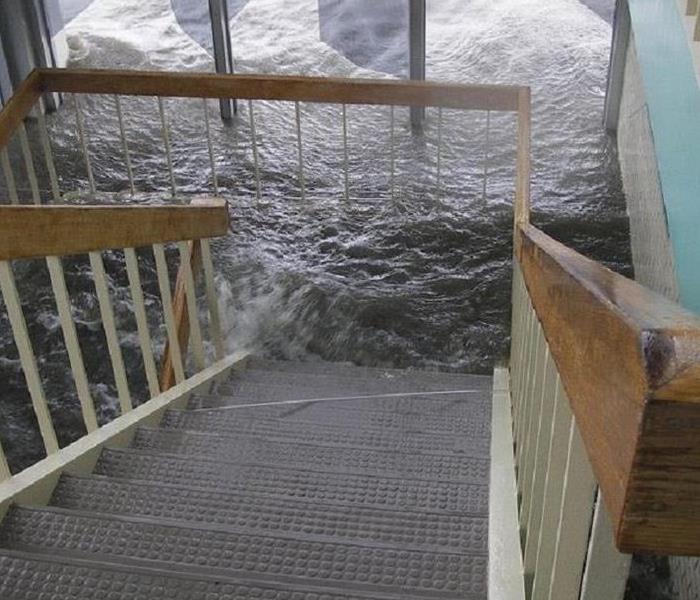 How to Clean Up from a Flooded Basement
How to Clean Up from a Flooded Basement
With the recent storms and flooding, many homes throughout central Indiana may have suffered from the unfortunate event of a flooded basement. There is nothing so frustrating as looking down your basement stairs and discovering that your basement is now under water along with all the belongings that you have stored down there. So you’ve discovered a lake in your basement, now what do you do? Below we will cover things you should do and shouldn’t do and how ultimately to clean and restore your flooded basement.
Be Careful - Water and Electricity Do Not Mix
If there is standing water in your basement, do not go near it. You should not assume that the power has been cut off by the home’s circuit breaker. If your home’s circuit box is located in a dry area of your home, then you should check the breaker box to see if the circuits powering the basement have been tripped and are off. If you have a hot water heater or furnace in the basement, they should be powered off also from the breaker box.
If you are unsure that all of the power is off in the basement, then wait until the water has completely resided or call an electrician or professional flood cleanup company. They will know what to check or who to contact to ensure there is no power going to the flooded basement.
You Don’t Know Where That Water Has Been
The second danger with a flooded basement is that you don’t know where the water originated. While it could be rainwater that has pooled up once the sump pump went out, it could also be from the municipal sewer system backing up. When the local sewer system floods and backs up, it heads to the lowest points first, which are basements. Some home’s main sewer pipes have check valves to prevent the sewer system from backing up into their basements but many homes do not.
If your basement has a floor drain or bathroom, the sewer system may back up into your basement. Obviously, you don’t want to get anywhere near that water as it can be harmful to your health. Since you don’t know where the water has come from, it always better to be safe than sorry. Wait until the water has resided and try to avoid any skin contact with the water. Even it is isn’t sewage water, it could contain other chemicals and contaminants from your basement or the flood waters outside your home.
So What Should Be Done If A Basement Floods?
As you can see, there are a lot of dangers from a basement flooding. The best thing to do if your basement has flooded is to call a water damage cleanup company, like SERVPRO of Indianapolis West. They have the expertise, equipment, and tools to remove the water, dry the basement, remediate any mold or potential mold, and restore your basement.
Once the water in the basement subsides or has been pumped out, then it’s a matter of removing all the water soaked items like furniture, storage boxes, area rugs, and more. If there is carpeting in the basement, it will probably need to be commercially vacuumed to extract the water If there is drywall in the basement, then it may need to be removed or at least partially removed. Drywall can absorb the flood waters and if not removed, it can lead to mold growth. All wood and porous surfaces must also be treated to prevent mold from growing. There are a lot of areas in a basement where the water can seep into and lead to extensive mold growth and damage.
Don’t Risk Further Damage. Contact the Water & Mold Damage Cleanup Professionals.
A flooded basement can be a huge mess that can quickly turn into an even bigger mess. That is why you should trust the professionals at SERVPRO of Indianapolis West to clean up your flooded basement and return it back to normal. They deal with flooded basements, homes, and businesses on a regular basis and know just what to do to clean and restore all the damage. Whether it is on the weekends or in the middle of the night, you can call them anytime to show up and get right at work to restore your flooded basements.
The Dangers of Stagnant Water & What to Do If Found
8/27/2018 (Permalink)
 The Dangers of Stagnant Water & What to Do If Found
The Dangers of Stagnant Water & What to Do If Found
Stagnant water, also known as standing water, is a body of water that does not flow or go away in a timely manner. This can be a small puddle in your backyard or a puddle in your crawl space. They both can result in problems for you and your home. The puddle in the backyard can become a breeding ground for mosquitoes and the puddle in your crawl space can result in damaging mold growth.
Stagnant water can come from any source. It can be clean water from a leaky water pipe or faucet. It can be from rainwater which is likely with the stagnant water in your yard. Or worse, it can be from a sewer line in your home or a sewer backup in your neighborhood. While the sewer water or black water, as it is known, can be the most dangerous to one’s health, they can all lead to mold growth, bacteria growth, and mosquito problems. The clean water can mix with debris, bacteria, and organisms and result in mold growth and other problems.
The Hidden Dangers of Stagnant Water
One of the problems with stagnant water is when it is hidden from our daily view. This could be some standing water hidden behind a woodshed that we never see or stagnant water that sits undisturbed and unseen for months in our crawlspace or basement. It is that time that can ultimately lead to extensive damage to your home.
The longer stagnant water sits in your crawl space, basement, bathroom, or garage; the more time it has to promote mold growth in your home. Once the mold has begun, it usually won’t stop growing until it is found and remediated by professionals, like those at SERVPRO of Indianapolis West. Given a little bit of time, mold can grow quickly on the floor joists, ducts, floors, walls, insulation and other surfaces nearby. Given a few months, mold can lead to structural damage to your home and spread throughout the home through the air or ducts.
What to Do If Stagnant Water is Found
If you find stagnant water right away, you may be able to remove the water without much damage. You need to vacuum or pump out the water and completely dry the area. You also need to remove any materials that got wet including clothing, furniture, carpet, padding, insulation, and drywall. Once all the damaged materials have been removed, you can sanitize the area to ensure the mold and bacteria don’t grow. While this may be good enough, many times it doesn’t work completely. Days or weeks later, the homeowner discovers mold or bacteria growth where they thought they had dried and cleaned everything.
The Best Thing to Do If Stagnant Found is Found
The danger of water getting into your subfloors, drywall, and structural beams is that they aren’t easy to get dry. They tend to soak up the water which can lead to mold growth in a day or two. That is why it is always best to call water damage experts to professionally remove, dry, clean and repair your home from water damage. Professionals, like those at SERVPRO of Indianapolis West, have seen and dealt with all kinds of water damage and know exactly how to handle your situation to ensure all the damage is removed and restored completely. This can include bringing in commercial dryers, dehumidifiers, and other equipment to completely remove all the water and moisture from the area. They also have industrial cleaners and tools to check and remove all the water and remediate any materials with mold growth.
It Doesn’t Take Much Water to Do Damage
It only takes a little puddle of water to create a lot of damage in your home. It’s always a good idea to check for standing water in your crawl space, basement, garage and other areas where it may occur on a monthly basis. You also want to make it a habit of checking inside, under and around your home after huge rain showers have rolled through your area. Not only may you spot trouble areas inside your home, but you may find trouble areas around your property where the water can lead to a mosquito infestation or stream back into your foundation and into your crawl space.
If you do find stagnant water inside your home, you can try to remove it as quickly as possible but you should definitely call SERVPRO of Indianapolis West. Not only will they remove the water but they’ll be able to evaluate your property for any damage or potential damage from the standing water. They’ll be able to keep your small problem from turning into a much bigger problem down the road.
Water Damage Categories
8/16/2018 (Permalink)
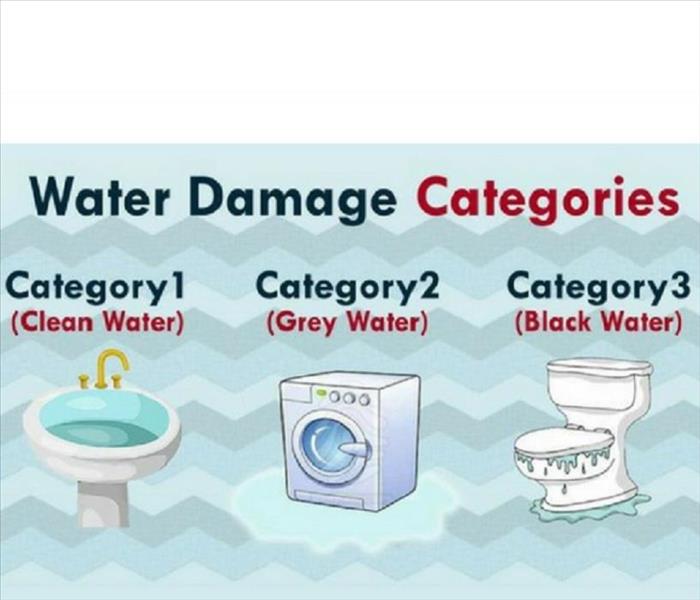 Three water damage categories.
Three water damage categories.
SERVPRO uses three different categories to define a water damage. Below, I’ll cover each category and examples of them.
We categorize water damages for a couple of different reasons. First, is to know and understand what level of precaution our water damage restoration technicians must use to stay safe while working in the environment. Second, we need to understand what materials the water has come in contact with to determine the proper cleaning process and also the restorability of building materials and contents.
Once we’ve determined the category of the water damage, we can then proceed with restoration catering to each category. For instance, building materials and contents in a Category 1 environment have a high chance of being fully restored, while materials and contents in a Category 3 environment have little to no chance of being restored.
Category 1 Water
Refers to a source of water that does not pose a substantial threat to humans. This water is classified as “clean water.” Examples are broken water supply lines, tub and sink overflows and appliance malfunctions that involve water supply loss.
Category 2 Water
Refers to a source that contains a significant degree of chemical, biological or physical contaminants and causes discomfort or sickness when consumed or exposed to. This water is classified as “grey water.” Examples are sump pump failure, some toilet overflows from the water trap up, and discharged water from dishwashers or washing machines.
Category 3 Water
Refers to water that contains unsanitary agents, harmful bacteria and fungi, causing severe discomfort or sickness. This is classified as “black water” and is grossly unsanitary. Examples are sewage backups, flood waters and water from rising rivers and streams. Category 2, grey water that is not promptly removed, or has remained stagnant, may be re classified as Category 3.
SERVPRO of Indianapolis West to the rescue.
Every water disaster is different, from the amount of water to the level of contamination of the water. Each scenario requires a unique solution. You can rest assured that SERVPRO of Indianapolis West has the expertise and training to properly mitigate any type or category of water damage, whether residential or commercial. Our Highly Trained Technicians will respond immediately when you call us. We’re always open for emergency water damage service, even nights and weekends.
Top Culprits of Water Damage in Indianapolis Homes
7/17/2018 (Permalink)
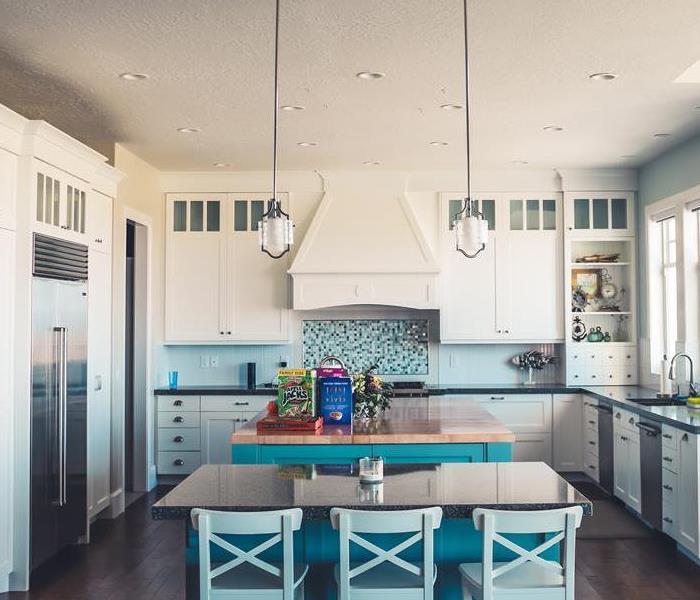 Top Culprits of Water Damage in Indianapolis Homes
Top Culprits of Water Damage in Indianapolis Homes
By knowing what the top causes of water damage to Indianapolis homes, you can be proactive and check these common culprits on a regular basis to reduce the chance of water damage occurring to your Indianapolis home. Below are the top causes of water damage to your home outside of a natural disaster like flooding.
Refrigerator
If you notice water pooling below your kitchen refrigerator, you most likely either have a water line that is leaking or a freezer that is not cold enough. Check the bottom of your freezer to see if there is standing water or ice forming. As the water or ice forms, it can melt and leak every time you open the freezer. If you don’t find ice or water forming at the bottom of your freezer, you may have a water line that is loose or leaking.
The water line is used to make ice and sometimes provide water in the refrigerator door. The line is usually located in the back of the refrigerator and can be knocked causing a slow leak. It’s a good idea to occasionally check around your refrigerator for standing water and fix the problem before the water gets worse or causes damage to your floors.
Dishwasher
Much like your refrigerator, a dishwasher can leak water for a while until it is discovered. The water line and/or the drain to the dishwasher is usually connected at the back of the dishwasher and any leaks could take weeks or months to appear. While you can’t do anything about hidden leaks, the other commonplace that a dishwasher leaks is around the door. If the seals around the door have been cracked or compromised, water can leak out while it is running and pool below the dishwasher.
It’s always a good idea to check on a regular basis around the bottom of your dishwasher for any standing water or signs of water. If you do find any signs, you can then further investigate to determine if it’s around the door or if it’s coming from the water or drainage line hidden behind your dishwasher.
Washing Machine
You can probably start to see a pattern here. While water can come through a damaged roof or windows or under doors, it’s common appliances and household items that are hooked up to water that tend to cause most water damage in homes.
The washing machine is no exception to leaking, with its water intake and water drainage. Water can also leak out around the door of the washing machine from old or damaged seals. Just like your dishwasher, it’s important to regularly check around your washing machine for any signs of water leakage. Check the water hookup, water drainage, and around the door for signs of water.
Toilet
The water leaking from a toilet can be particularly bad. If the water is leaking from the back tank, then the water is most likely clean and while it is still bad, it’s not as bad of a situation if the water leaking is coming from around the toilet drain. Toilets usually drain the content of their bowl down underneath the toilet where it connects with the sewer drain. To prevent leaking and odors, the toilet drain is seated with a wax ring into the sewer drain. If your toilet is not completely bolted down or becomes loose over time, the wiggling can break the wax seal causing dirty, contaminated water to seep out below the toilet. If not discovered, this water can seep into the floor and cause serious water damage and most likely mold damage.
If you notice your toilet wiggles, check for any signs of water leakage and tighten down your toilet. If you do find water, then you may have to buy a new wax ring and reseat your toilet although you might want to have a water damage professionals check for any water or mold damage before tightening back the toilet.
Air Conditioner
The last common source of water damage in homes is the air conditioner. Whether you have a central air conditioner or window ac units, they both can cause water to leak and damage your home. In both systems, the air conditioner typically creates a lot of condensation when running in the hot summer. This condensation is usually gathered in a pan where it then drains outside or into a drain. If the drain becomes clogged, the water in the pan can overflow and drip inside your home or into other parts of the air conditioner where it can promote mold growth.
If you notice your vents are blowing air that smells moldy or like a damp basement, then you need to check for standing water or mold growth around the blower, filter, and cooling coils of the unit. You might also find water dripping or pooling around the unit. Again, just like your other appliances, it’s a good idea to regularly check your air conditioner as well as maintain it.
If You Do Have Water Damage, Call the Pros
If you do discover water damage from any of the above culprits or from other places like a leaky roof or burst pipe, it’s important to call water damage restoration experts at SERVPRO of Indianapolis West as soon as possible. Water damage can quickly get much worse if not treated immediately. Water can seep and soak further into the floors and walls causing more damage and it can also promote mold growth if not removed and treated quickly. Hopefully, you don’t have any water damage and catch it in time by regularly checking the culprits above.
Reduce the Risk of Water & Mold Damage with these Springtime Tips
3/30/2018 (Permalink)
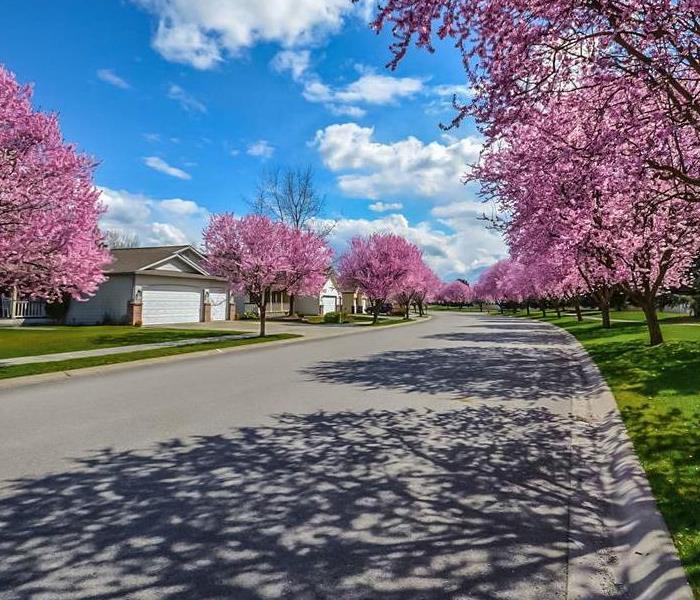 Reduce the Risk of Water & Mold Damage with these Springtime Tips
Reduce the Risk of Water & Mold Damage with these Springtime Tips
Winter is Over. Did Your Home Survive?
Springtime is upon us in Indiana. It’s time to start thinking about planting some flowers and getting your lawn mower ready to start the long mowing season. There are lots to look forward to in the Spring but there are also lots of things that need to be done to make sure your home is up for the season. Below we cover five things to check in your home to make sure it is free of water damage and mold damage - and ready for Springtime.
#1 Check Your HVAC System
As the warm weather approaches, you need to make sure your air conditioner is ready. The first thing to check and most likely replace is the air filter. The air filter catches allergens and reduces the buildup of dust in your home’s air ducts.You should also make sure that there is no standing water or dirty air coils where mold can grow and then be pushed through the air ducts.
#2 Check Around Your Windows & Doors
During the winter, water can seep into cracks around your windows and doors and freeze. The freezing water can expand causing the tiny cracks to grow to allow more water to enter into your home. Check around the outside and inside of all your windows and doors. Look for cracked or missing caulking. If you find any cracks where water could enter your home, be sure to caulk or seal the holes.
#3 Check Your Roof for Damage
When it’s nice out and your roof is dry, climb up there and do an inspection. Check to make sure your gutters are clear. Otherwise, water could run over the gutters and cause water to enter through your foundation and into your basement. Also, check to make sure there are no missing shingles. If you have exhaust pipes or chimneys, check around them to make sure they are sealed and there are no signs of cracking.
#4 Check Attics, Basements and Crawl Spaces for Mold
As the ground thaws out from the Winter, water make find its way into your crawl spaces and/or basements. If you have any roof damage, it could seep into your attics. Make sure to check all these areas for any signs of water. This could be standing water or water stains. If your basement or crawl space smells musty, then you may want to get a dehumidifier to remove the excess moisture from the area before it leads to mold growth. If you do find mold growth or water that you can’t remove, then call the professionals at SERVPRO of Indianapolis West to help remediate the mold damage.
#5 Check Exposed Water Pipes
If you have water pipes in your basement, crawl space, and/or crawl space that you can see, make sure to check them for any drips around the joints. During the Winter, these pipes could have frozen causing the pipes to expand and crack. Even a small drip can lead to extensive water damage and/or mold growth. It’s also a good idea to check any external faucets for cracks or leaks. If you find any sign of leaks, make sure to have it fixed before it leads to even worse damage.
Enjoy a Stress-Free Spring
While you can’t completely reduce the risk of water damage to your home, you can lower the risk by following the five steps mentioned above. If you should experience water damage or find mold growth when inspecting your home, contact SERVPRO of Indianapolis West online or call them at 317-243-3149 to help clean up the damage and restore your home.
Top 5 Reasons to Choose SERVPRO of Indianapolis West for Water Damage Restoration Service
3/29/2018 (Permalink)
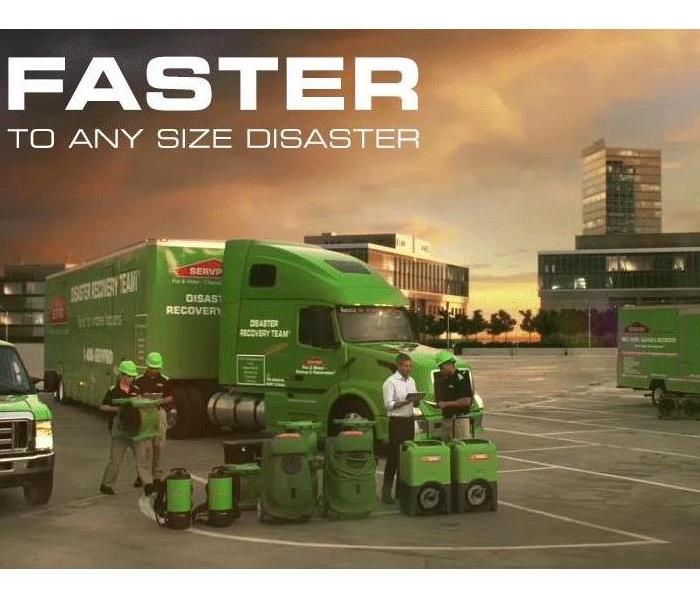 Top 5 Reasons to Choose SERVPRO of Indianapolis West for Water Damage Restoration Service
Top 5 Reasons to Choose SERVPRO of Indianapolis West for Water Damage Restoration Service
With the rainy Spring season upon us, many homes and businesses will be the unlikely victims of water damage. Some may experience flooding in low lying areas while others may experience leaky roofs or windows or flooded basements.
While there are many ways for water to creep into your home, there’s one sure choice when it comes to choosing someone to remove it. With one call to SERVPRO of Indianapolis West at any time and any day, they can be at your home and business removing the water and restoring any damage that it may have caused.
Why is SERVPRO of Indianapolis West the best choice in the Indianapolis area when it comes to water damage restoration? Here are the top five reasons why you should give them a call the next time you experience water damage:
#1 IICRC Certified Professionals
The IICRC is the leading, independent, non-profit, certification and standard-setting body in the cleaning, inspection, and restoration industry. When choosing a water damage, mold remediation, and/or fire and smoke restoration company, be sure to ask if they are IICRC certified.
At SERVPRO of Indianapolis West, the team holds IICRC certifications in water removal technician (WRT), applied structural drying (AST), mold remediation technician, and lead paint remediation. The team also participates in ongoing training at SERVPRO’s corporate training facility.
#2 Ready for Any Emergency 24/7
A disaster can strike at any time and any day which is why SERVPRO of Indianapolis West is ready to answer your call 24/7. With water damage, time is of the essence and it’s important to start the process of removing the water quickly before it can cause further damage or lead to mold growth. SERVPRO of Indianapolis West realizes that every water damage situation is an emergency which is why they are ready to help out whether it’s day or night.
#3 Known and Trusted for Over 50 Years
SERVPRO has been around for over 50 years. That’s 50 years of industry experience and know-how in the fire and water cleanup and restoration industry. When you call SERVPRO of Indianapolis West you can trust that they have the skills and the expertise to handle any emergency no matter how big or how small. There are not many fire and water restoration companies that can say they’ve been around as long.
#4 Advanced Equipment, Treatments and Techniques
With that 50 years of experience comes 50 years of learning the best techniques and the right treatments to cleaning and restoring business and homes from fire and water damage. Along with the best treatments and techniques come some of the most advanced equipment in the industry. Trust and reliability and excellent results come from 50 years of experience dealing with every disaster imaginable.
#5 Experts at More Than Just Water Damage
Many times, water damage isn’t the only thing that a homeowner or business owner is experiencing. If the water damage has been happening over a period of time, there could be underlying mold damage.If a home or business experience a fire, there could be water damage from the fire department and/or sprinkler system. If the water isn’t removed completely, there could be water damage and mold growth. Luckily, SERVPRO of Indianapolis West can handle all of those quickly and professionally.
Call the Experts for Water Damage Cleanup and Restoration
If you should, unfortunately, experience water damage to your business or home, call the experts at SERVPRO of Indianapolis West. They have the expertise, the knowledge, the equipment, and the know-how to remove the water and restore your home or business. Contact SERVPRO of Indianapolis West online or call them at 317-243-3149.
Winter Tips to Prevent Water Damage from Frozen Pipes Bursting
11/28/2017 (Permalink)
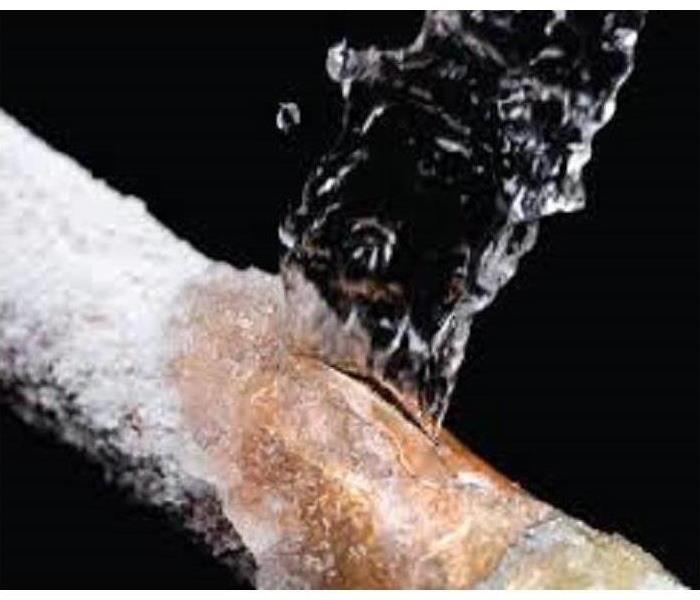 Frozen Pipes
Frozen Pipes
With the cold weather upon us, it’s important to take some steps to ensure you don’t experience water damage from pipes freezing and bursting. Below we will cover some common areas where water pipes are prone to freeze and how to prevent that from happening.
Top Locations Where Water Pipes May Freeze
How To Prevent Pipes from Freezing & Bursting
If you have water pipes that run through an uninsulated or under-insulated area like a garage or crawlspace, you can purchase pipe insulation sleeves that slip over the exposed pipes. These black foam sleeves can easily be cut and usually have an adhesive that sticks to the pipe so they don’t slip off.
It’s OK to open your garage door to get the car out or for the kids to grab their sleds but never leave it open for extended times. Remind your kids to shut it right away after opening it. It doesn’t take long for the bitter cold to freeze an exposed water pipe in your garage.
- Open Kitchen & Bathroom Cabinets
During really cold days and nights, you might want to consider opening up the cabinet door under your kitchen sinks and bathroom sinks that are against an exterior wall. Kitchen sink water pipes are one of the most common water pipes to freeze due to the fact that kitchen sinks are usually facing an exterior wall.
- Keep Thermostat Set Above 55 Degrees
While you obviously won’t have your thermostat set that low while you’re home, many people do set their thermostats that low when away for vacations. If you want to save a little money by turning your thermostat down while you’re away for a week or even the whole winter season, be sure to at least keep it at 55 or above. This will ensure that any water pipes that may be far away from your thermostat will still be warm enough not to freeze.
- Insulate Crawl Spaces and Attics
Many attics and crawl spaces have very minimal insulation. The insulation that there is in an attic or crawl space is usually there to insulate that area from the rest of your house and not the actual attic or crawl space. If you have water pipes that run through your attic or crawl space, you can insulate the entire area or you could just insulate the water pipes in the area as described above.
- Shutoff Valves to Exterior Spigots
Many exterior spigots are frost-proof to prevent them from freezing and bursting. If your spigots aren’t frost-proof or you don’t know, you can do one of two things to prevent them and the pipes they’re connected to from freezing and bursting. You can buy a spigot insulator that is usually a piece of styrofoam that covers the spigot or you can cut off the water to the exterior spigots and drain the remaining water in the pipes by opening up your spigots.
What to Do If a Pipe Does Burst
If you happen to have a water pipe burst in your home, the first thing you want to do is turn off the water to your home or to the area where the pipe has burst. The next step is to deal with all the water and water damage. Even a little water can get under carpets and behind walls and lead to more problems like mold.
It’s important to call the water damage restoration experts of SERVPRO of Indianapolis West immediately. We will work right away to identify the steps to clean and restore your home while taking steps to prevent any unnecessary further damage from occurring.
If you should suffer water damage at your home, call SERVPRO of Indianapolis West at 317-243-3149 to start taking the appropriate steps to clean and restore your home as if nothing ever happened.
Water Damage Restoration Service Professionals in Indianapolis
9/23/2017 (Permalink)
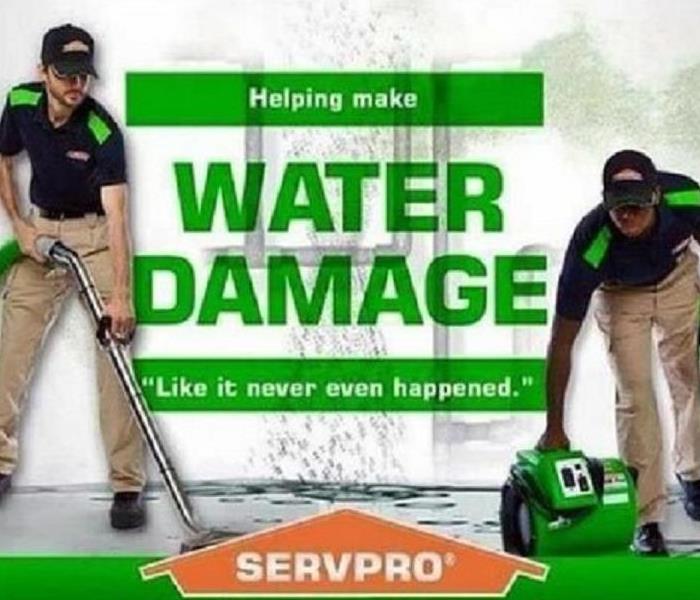 Water Damage Restoration Professionals
Water Damage Restoration Professionals
If you are looking for professionals who have the knowledge and expertise to restore your home and property after it has suffered water damage, then you call SERVPRO of Indianapolis West.
The water damage restoration professionals of SERVPRO of Indianapolis West service businesses and homes that have suffered water damage around the Indianapolis area including Plainfield, Greenfield, Avon, Zionsville, Carmel, Fishers and beyond.
If you’ve had a pipe burst or a leaky roof or a toilet or tub that has overflowed, call SERVPRO of Indianapolis West to clean up the mess and restore your home as if nothing ever happened.
When to Call Water Damage Restoration Professionals
Water damage to an Indianapolis-area business or home can be caused in many ways. Heavy storms can reveal roof leaks and foundation cracks that let the water inside. During the winter months, pipes exposed to cold temperatures can freeze and burst.
Toilets, sinks, dishwashers, and clothes washers can slowly leak behind walls, under floors, and inside cabinets. Sewers can back up into basements and through the drains on lower levels of homes.
As you can see, there are many ways water can get into your home and damage it. While one may think that drinking water or rainwater isn’t as damaging as sewer water or black water, that’s not really the case.
Will Clean Water Damage My Home?
While sewer water or blackwater as is it defined can quickly lead to mold growth in a home, clean water can also lead to dangerous mold growth. Blackwater contains lots of dirty bacteria that can quickly promote mold growth by itself.
Clean water can cause mold spores that are naturally present in air and dust can also lead to mold growth. The dangers in clean water leading to mold growth are that clean water can easily go unseen in a home due to the lack of odor when compared to black water.
Clean water or gray water which is rainwater, can leak into a home’s attic or walls or crawl spaces and linger without being spotted. This water can then lead to mold spores activating and growing in these unseen areas. It’s not until the mold spreads to visible parts of the home or causes a musty odor that it is finally found. By that time, the damage caused by the mold can be quite extensive.
Look for the Signs of Water Damage and Call the Experts Right Away
Whenever it rains, it’s always a good idea to check around your home for any leaks. Check the external walls, the ceilings and around windows. If you have a basement or crawlspace, check it for any water entering into your home. Always check around sinks, tubs, showers, and washers for sitting water or even the smallest of leaks. It doesn’t take much water to cause damage to a home.
The quicker you spot a leak or water in your home, the quicker you can call water damage restoration experts like those at SERVPRO of Indianapolis West to stop the damage and restore your home.
SERVPRO of Indianapolis West has the experience, expertise, and tools to properly and effectively remove the water and mold damage and restore your home as if nothing ever happened. Call SERVPRO of Indianapolis West today at 317-243-3149 to learn how we can help with fire, smoke, water and mold damage.
How to Clean Water Stains From Ceiling?
8/18/2017 (Permalink)
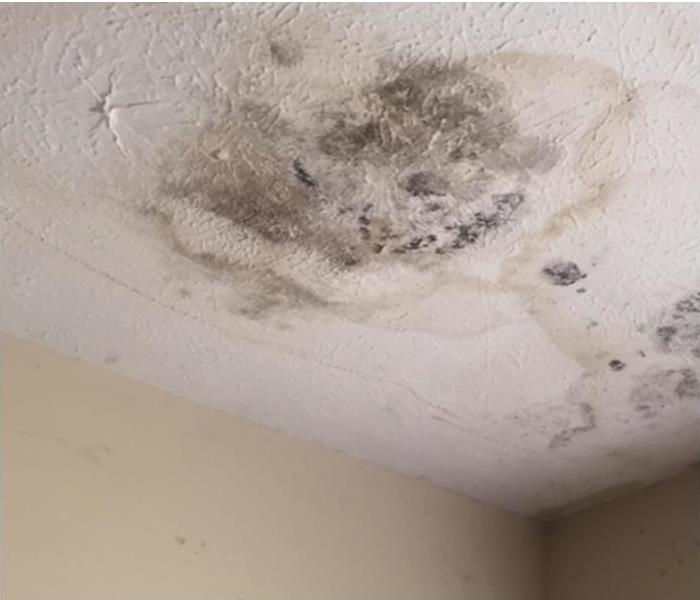 How to Remove Water Stains from a Ceiling
How to Remove Water Stains from a Ceiling
Have you noticed water spots appearing on your ceiling? Perhaps you were laying down on the couch and noticed a small discolored spot on the ceiling above you. Maybe you were trying to grab that dish off the top of your cabinets and suddenly noticed a water spot. Or maybe you’re checking the ceiling above you right now and notice some discoloration. So now that you see it, how do you get rid of it?
You Can’t Paint Over A Bigger Problem
You could paint over the spot and hope it doesn’t show through and perhaps you already have. The problem is you’re only covering up a bigger problem that lurks beneath the ugly water spot on your ceiling. If water has penetrated your ceiling to create a water spot, then the water most likely has also penetrated the insulation, the roof, and any framing around the water spot. Even if you stop the leak from outside your home and cover the water spot on your ceiling, you still have to deal with the water damage between those two spots in your home.
Why Can’t I Just Fix The Leak And Paint Over the Water Stain?
Water that leaks in from your roof isn’t clean water. While it may not be black water like you see from a sewer, it can contain organic materials that can easily promote mold growth. Even if it was clean water, mold could still result as mold spores only need moisture to grow. By stopping the leak and painting over the water spot on your ceiling, you still have the risk of mold growing above the ceiling in the insulation, framing, and roofing. This mold can then spread throughout your attic and get into your air ducts and rooms causing damage to your home and health.
What To Do If You Find A Water Stain on Your Ceiling
A water stain or spot on your ceiling could mean you have a leak on your roof. It could also be caused by a leaky pipe or condensation dripping from a pipe above your ceiling. If you find a water stain or worse, black mold, on your ceiling, call the water damage restoration professionals at SERVPRO of Indianapolis West at 317-243-3149. From fire to flooding to water damage to storm damage and everything in between, SERVPRO of Indianapolis West has the experience, equipment, and expertise to make it "Like it never even happened."
Spring Showers Bring Potential Water Damage
4/1/2017 (Permalink)
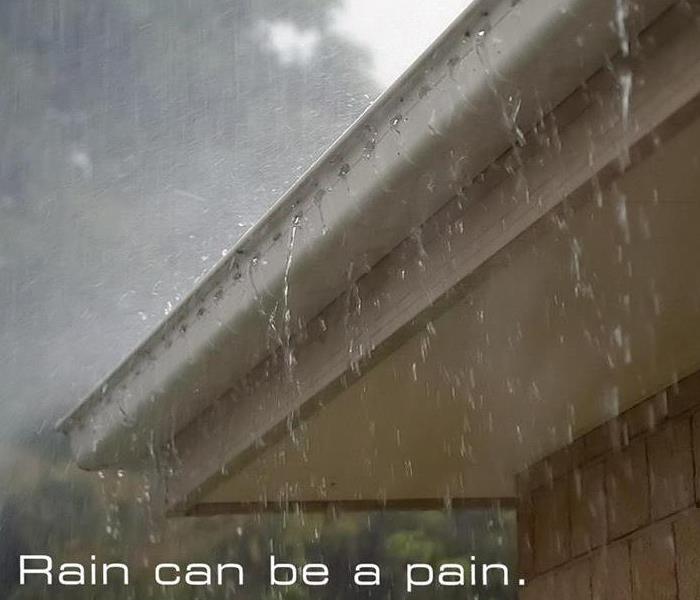 Spring Showers Bring Storm Damage and Water Damage to Homes
Spring Showers Bring Storm Damage and Water Damage to Homes
While many of us look forward to the changing season of Spring with the warmer weather and the trees and flowers starting to bloom, there is one part that isn’t so great. Springtime always seems to bring plenty of rain and plenty of rain always brings a higher risk of water damage to your home.
Roof Leaks
With the increased showers as well as high winds, roof damage can happen or be revealed as water seeps through your roof and damages your ceilings and walls. To reduce the risk of roof leaks, you should inspect your roof for any damages from the winter and inspect it after every major storm.
The most common cause of roof leaks is a damaged or missing shingle from storms or fallen branches. If you do experience water damage inside your home from the ceiling or wall, you will want to contact a professional from SERVPRO to inspect the damage, remove the water, an remediate the damage.
Window & Door Leaks
Another common source of water damage is from old or damaged windows. Water especially from a huge storm can blow into cracks and crevices around your window causing water damage that may not be discovered quickly allowing mold to develop and cause further damage.
Make sure to inspect around your windows and doors for cracks or old caulking that has peeled or cracked off. You can usually caulk any small cracks or crevices to ensure water doesn’t seep into your home causing damage.
Broken Sump Pump
If you have a basement, you understand the importance of a sump pump. Without one water can seep into your basement and cause lots of damage. One of the most common causes of a flooded basement is a sump pump that stopped working.
To prevent this from happening, you can do three things. You can get a backup battery for your sump in case the power goes out. You can get a backup sump pump that is usually set to come on if the water rises above the normal level for your working sump pump. So if your working sump pump either stops working or can’t pump the water out fast enough, you backup will kick in.
The last thing you can do is install a water sensor alarm on the floor near the sump pump. While you may still have some water damage, at least you will be able to catch it fast and have a SERVPRO professional come out to pump out the water and dry out your basement.
Foundation Cracks
If the foundation around the base of your home and the basement walls cracks, water can seep into the basement or crawl space. A sump pump won’t help you since the water is seeping through the walls as opposed to being channeled to the sump pump.
Usually people discover foundation cracks after a big storm or when a gutter is clogged and the water is falling right by your house. Repairing foundation cracks can be a very expensive job depending on the situation but without the repair, there is no way to prevent the water leaking into your basement or crawlspace.
It never hurts to walk around the perimeter of your home checking for any potential foundation cracks as well as checking any bare walls in your basement and/or crawlspace.
Call the Pros of SERVPRO for Water Damage This Spring
If you should suffer water damage whether from Spring weather or a cracked pipe or an overflowing bathtub or toilet, call the water damage cleanup experts at SERVPRO of Indianapolis West at 317-243-3149 for 24-hour emergency service. You can also click here to contact us online.
At SERVPRO of Indianapolis West, we have specialized equipment, professional training, and certifications that allow us to restore your home to its pre-water damage condition.
Sometimes Water Damage Can't Be Prevented
9/11/2016 (Permalink)
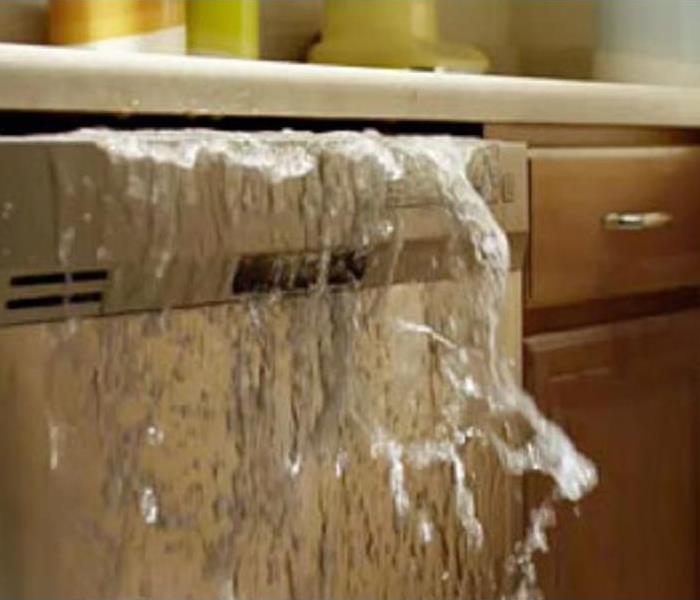 Water damage to Indianapolis homes can happen anytime.
Water damage to Indianapolis homes can happen anytime.
The new iPhone 7 may be waterproof but just like a home, water can find a way into it. With flooding, cracked pipes, a leaky roof, or a broken sump pump; water can find a way into your home and damage it. And hopefully just as you have insurance for your mobile phone, you also have insurance for your home.
If your home does happen to suffer from water damage, you can trust the experts at SERVPRO of Indianapolis West to clean up the damage before more has occurred. At SERVPRO of Indianapolis West, we have the knowledge and experience to handle all types of water damage. Whether it is from a flood, a backed up sewer, a roof leak, or a frozen pipe that has burst; we have the specialized equipment and professional-grade products to quickly remove the water from your home. Once the water is removed, we'll then focus on completely drying out any remaining water and moisture in the damaged areas. We'll also remove and treat any areas that may promote mold growth.
The Hidden Danger of Water Damage
While unwanted water in a home can certainly cause damage to drywall, wood floors, furniture, clothes, and other porous materials; it's the mold growth that the water promotes that can cause the most damage. Not only can mold cause substantial damage to one's home but also to one's health. That is why it is imperative to seek water and mold remediation professionals immediately after water damage has occurred. Water and mold remediation professionals, like those at SERVPRO of Indianapolis West, will work quickly to remove all water and moisture from the affected area. They will then clean and treat the area to prevent mold growth from occurring. Once the area has been completely dried and has been inspected to make sure there are no mold spores or signs of mold growth, then the damaged area can be repaired. This can include replacing the drywall, carpeting, wood floors, and sometimes subfloor depending on how long the water damage has existed.
Call The Water & Mold Damage Experts
Hopefully, you have caught the water damage early and it can be quickly remedied. But if you do have long-term water damage from a leaky pipe or roof, we have the expertise and the tools at SERVPRO of Indianapolis West to make it "Like it never even happened." The moment you experience or spot water damage in your home, call us anytime at 317-243-3149. Our highly trained technicians will respond immediately to your residential or commercial emergency. Whether you're in Indianapolis or the surrounding communities, we'll be there faster to your disaster than any other.
Hidden Dangers of Water Damage
6/27/2016 (Permalink)
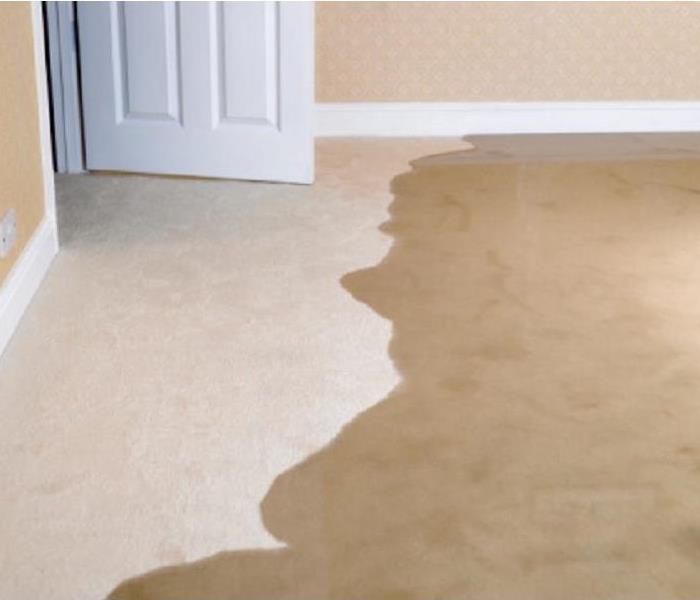 What may seem harmless can turn into severe damage.
What may seem harmless can turn into severe damage.
Do you have a small roof leak or a water spot on the floor where bathwater splashes? While those little leaks and water stains may seem inconsequential, huge damage and potential health risks could be hidden underneath the surface. So what are the signs you should be looking for of further water damage to your Indianapolis home?
If you have a small water stain on your ceiling, you first want to determine where the water came from. If you have access, above the ceiling like an attic, you can get up there and look for signs of a water leak from the roof or a leaking pipe. Even condensation from a pipe can cause water to drip and stain a ceiling over time. The source of the water leak is not always right above the water stain. Water from a leak can travel down the wood framing, across wires, along pipes and other structural pieces behind your home's ceilings and walls.
If you are unable to look behind the wall or ceiling, you may want to call water damage restoration experts like us at SERVPRO Indianapolis West. We have the expertise and tools to examine the full extent of the water damage and determining the best steps to take to repair the water damage and stop any further damage from happening.
Another sign beside a water stain of water damage is a soft spot on your home's walls, ceilings or floors. This happens a lot around bathtubs, kitchen sinks, windows and external walls. While there might not always be a water stain or obvious sign of a water leak, a spot where you can push in on the floor or wall or ceiling can be a sign of water damage that is hidden below the surface. This could be an easy restoration or a potentially difficult one where there could be mold damage and extensive damage to the house's structure.
In any case, the sooner you call us, the faster the damage can be stopped and repaired. When we come to a home with potential water damage, we work quickly to identify the source of the water damage, the areas of the home that have been affected, and the steps to take immediately to stop the water leak and restore the water damaged areas as if nothing ever happened.
While a simple roof leak or water stain can be covered up, the unseen damage that mopping up the water or painting over the water stain can't fix could be even worse and getting worse as time goes by. Don't risk damaging your home from water by ignoring or covering up the problem. Call us immediately so we can find and stop any further damage from happening to your home and to your health.
What's the difference between clean water, gray water, and black water?
5/17/2016 (Permalink)
 Clean, gray or black water?
Clean, gray or black water?
What's the difference between clean water, gray water, and black water? And why are they all bad when it comes to flooding and water damage to an Indianapolis home or business?
What is Clean Water?
Clean water is water that comes from your faucet or shower head that you can drink safely. It is also considered rain water or snow melt. In regards to water damage to your home, it can come from a broken water line, a busted toilet tank, a leaky washer or refrigerator, or rain or snow melt entering into your home or basement. While clean water flooding your basement or floors may not cause an immediate health risk, it can quickly evolve into gray water after prolonged contact with building surfaces, material, and items. This can happen within 48 hours which is why it is important to call SERVPRO of Indianapolis West as soon as possible after a flood or water damage.
What is Gray Water?
Gray water is water that may contain chemicals or contaminants that may be harmful to your health. Gray water can come from the shower and sink drains, the washer drain, the dishwasher drain, and aquariums. Gray water can cause even more damage than clean water and can evolve into black water within 48 hours causing even further damage and health risks.
What is Black Water?
Black water is contaminated water from floodwaters and sewage waters. Black water can come from a flooded river or a backed up toilet or a backed up sewage line in your home. Black water can contain all types of harmful contaminants like bacteria, mold, and viruses that can be extremely harmful to humans. Black water can cause diseases and illnesses like cholera, hepatitis, and NoraVirus. Black water can be very dangerous to ones' health and it is imperative to call a professional cleanup team like SERVPRO of Indianapolis West immediately. If the water damage from black water isn't professionally removed, dried out and cleaned, infections and illnesses can occur from microbes in the air and dust. That is why it is crucial that you hire professionals that have the right tools and processes to ensure a thorough cleanup.
Time is Not On Your Side
If your home or business suffers water or flooding damage, you need to take immediate steps to dry out the property as quickly as possible. With black water, it is imperative that you call us immediately and not try to clean up the water yourself as this can be very dangerous to your health. Even with gray water, if you are unsure what contaminants may be in the water, it is usually best to rely on professionals, like us, who can test the water, extract the water, and take the appropriate steps to clean the property and ensure there are no health risks from contaminants. Even with clean water, if you do not completely dry the areas that were damaged, the clean water can quickly turn into gray water which can turn into black water just as quickly.
At SERVPRO of Indianapolis West, we have extensive experience with water and flood damage in homes and businesses in the Indianapolis area. We have the professional equipment, tools, cleaning solutions and expertise to properly extract the water, dry the property, clean the property and repair the property as if the water damage never occurred.
Choosing a Flood Cleanup Service in Indianapolis
5/12/2016 (Permalink)
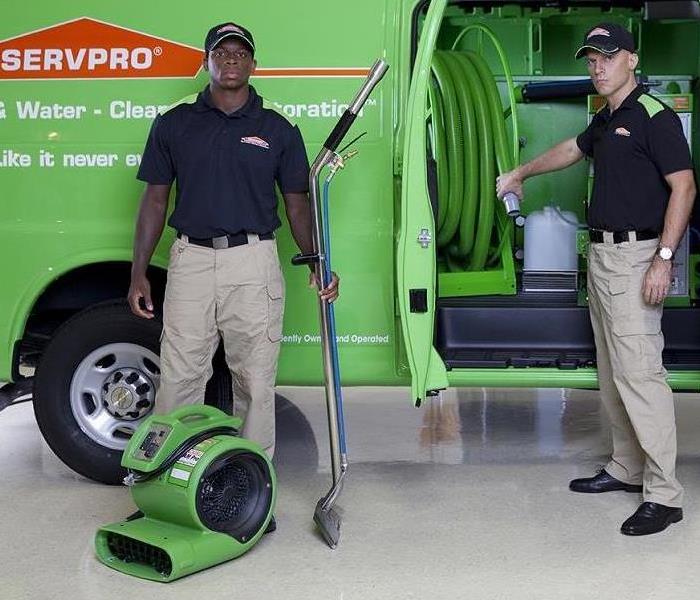 Choose the company that's faster to any size disaster. SERVPRO of Indianapolis West
Choose the company that's faster to any size disaster. SERVPRO of Indianapolis West
With the never-ending rains and storms of Spring time, we get a lot of calls for flood damage cleanup and restoration in the Indianapolis area. While we do see homes flooded from rising rivers, most of the water damaged homes we see and clean up are from flooded basements. In either case, it’s usually a good idea to let the professionals extract the water, clean up and restore your flood damaged home.
Timing is Important. Call Us Immediately.
It’s always best to clean up the flood and water damage as quickly as possible. Fortunately, at SERVPRO Indianapolis West, we are available 24/7 and will take care of your flood and water damage before it has time to get even worse. Timing is important when cleaning up water damage. If the water and moisture aren't removed quickly, you could be facing further damage from mold and mildew, which we can also help remediate if it does occur.
Why DIY Flood Cleanup May Not Be a Good Idea
The danger in DIY flood cleanup is that water from flooding tends not to be the cleanest water and can easily seep into every crack and porous surface in your basement and home. It can seep under your floors, into your air ducts, through the drywall and insulation, and into the wood framing of your home. A simple mop and some box fans won’t be enough to extract all the water and dry everything that is water damaged. Which is why you should rely on SERVPRO of Indianapolis West to professionally extract all the water, repair all the damage, prevent and/or remediate any mold growth, and restore your Indianapolis home as if it never had any flood and water damage. We have advanced water inspection, extraction, and drying equipment as well as years of experience to handle any and every type of water damage. From floods to broken pipes to sewage backup and to flooded basements, we have seen it all and we have cleaned it all.
Stree-Free Insurance Claims Process
If your insurance policy covers your water damage, we can work with you and your insurance company to quickly clean up and restore your home from flood and water damage. We can help manage the insurance paperwork for a stress-free claims process. So if you have a flooded basement, a leaking roof, a sewage backup, a broken pipe, or a rising river that is damaging your home or business in the Indianapolis area, then call us at 317-243-3149 for immediate emergency response to reduce the chance of further damage from mold and standing water.
Tips to Reduce the Risk of Water Damage to Indianapolis Homes and Businesses
3/9/2016 (Permalink)
 Indianapolis Rains causing Storm, Flooding and Water Damage.
Indianapolis Rains causing Storm, Flooding and Water Damage.
April showers bring May flowers and water damage to Indianapolis homes and businesses. With Spring upon us, we at SERVPRO of Indianapolis West receive many emergency calls of Indianapolis businesses and homeowners seeking water damage cleanup and restoration. Water damage can happen for many reasons. In the winter times, we often see burst pipes causing water damage to drywalls, floors, basements and more. In the warmer months, especially during the rainy Spring months, a majority of the water damage we see to businesses and homes are caused by flood waters, sewer backups, sump pumps failing, and leaky roofs & structures. While you can’t stop the rain, you can take some steps to reduce the risk of water damage to your home or business.
Check your Sump Pump
If you have a sump pump in your Indianapolis basement or lower level, you should check that it works properly. If you can access the pump area, you can fill up the holding area to check that the sump pump turns on and quickly removes the water. If you are unable to test your sump pump this way, you can wait until it is raining and check to make sure the sump pump turns on and operates correctly. If your sump pump has a battery backup, then you should unplug your sump pump and test it to make sure the battery backup works. Even by following these preventative steps, your sump pump can still fail and the results could be a very wet basement. If this happens, it’s important to call us immediately in order to reduce any further damage that standing water can cause like mold and mildew. We can quickly remove the water from your basement and sanitize the area to keep any mold or mildew from growing. One last piece of advice is to invest in a flood alarm. This affordable alarm detects rising waters in your basement or lower level and will sound an alarm so you can take immediate action before things get much worse. You can find these alarms at most hardware, home and big-box stores in the Indianapolis area.
Check for Roof and Window Leaks
The next thing you can do to reduce the risk of water damage to your Indianapolis home or business is to check for signs of water leaks from your roof, windows, doors and walls. Walk around your home and/or business and check the ceilings, walls and floors for water stains. If you find a water stain, check to see how soft the area is by pushing on it with a pen or your finger. If the area is soft, it’s usually a sign that the water leak causing the water stain is not new and is a leak that is happening on a regular basis either from rain water coming in or a water pipe that is leaking. If the damage isn’t bad, you can usually find the cause of the leak and seal it up. If the ceiling or wall is soft or the stain is significant, you should call us to inspect the damage and to find out if there is further damage that is hiding behind the walls or ceilings. Much like a wet basement, a wet ceiling or wall can cause mold and mildew to proliferate and cause further damage. The other area to check for leaks is around your windows and doors. You can usually use a spray hose and spray your windows and doors to check for any tiny leaks that may cause water from a storm to enter your home or business. If there are any areas that are allowing water to enter around your doors or windows, sometimes a little caulk or a new door seal can stop the leak and sometimes you may need something more significant, like a new door or window.
When Water Damage Happens
Even if all the preventative steps you can take, you can never reduce completely the risk of water damage to your Indianapolis home and/or business. Sump pumps will still fail, flood waters will always rise and storm waters will always find a way into homes and businesses. So if this happens to you and you live in Plainfield, Avon, Speedway, Brownsburg, or the surrounding Indianapolis areas, just give us a call at 317-243-3149 and we will be there quickly to handle your water damage cleaning and restoration needs.






 24/7 Emergency Service
24/7 Emergency Service












































